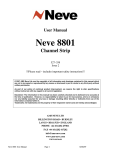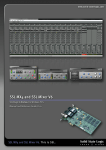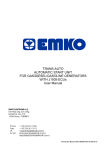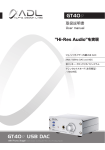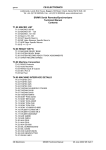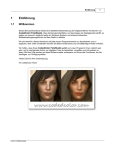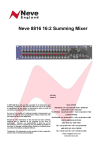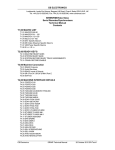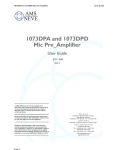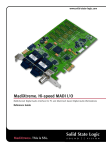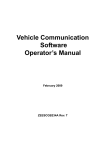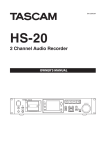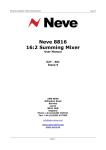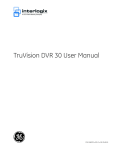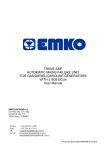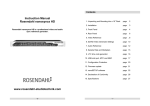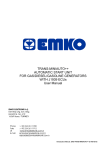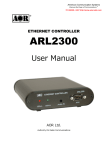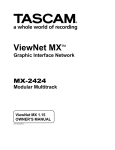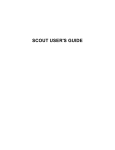Download GX9000 User Manual
Transcript
Genex Audio Inc GX9000 User Manual Table of Contents Transport Controls .................................................................................................................................. 7 Play...................................................................................................................................................... 7 Stop ..................................................................................................................................................... 7 Fast Forward and Fast Reverse.......................................................................................................... 7 ±10 Seconds........................................................................................................................................ 7 Previous and Next ............................................................................................................................... 7 Jog ....................................................................................................................................................... 8 Shuttle.................................................................................................................................................. 8 Varispeed ............................................................................................................................................ 8 Front Panel Displays ............................................................................................................................... 9 Timecode Display ................................................................................................................................ 9 Absolute vs. Relative Timecode in FAT32 Disk Format.................................................................... 10 Setting the Relative Reference Point ................................................................................................ 10 Absolute vs. Relative Timecode in Genex Disk Format .................................................................... 10 Time Remaining / Cue Point Display................................................................................................. 11 Menu Operation .................................................................................................................................... 12 Displaying and Navigating the Menu................................................................................................. 12 Changing Menu Levels...................................................................................................................... 12 Changing the Value of a Menu Option .............................................................................................. 13 Working with Media...............................................................................................................................14 Blanking Plates.................................................................................................................................. 14 Hard Drives........................................................................................................................................ 14 Magneto-Optical and DVD Drives ..................................................................................................... 16 Tape Drives ....................................................................................................................................... 16 Configuring Storage Devices ................................................................................................................ 17 Formatting Media...............................................................................................................................21 Projects and File Handling (FAT32 Format Only) ................................................................................. 22 How Do I Create a Project?............................................................................................................... 22 How are Project Files Named?.......................................................................................................... 23 How to Locate Project Files on a Disk Volume ................................................................................. 23 Navigating Through Folders .............................................................................................................. 24 Opening an ADL Project or Audio File .............................................................................................. 24 Large File Handling ........................................................................................................................... 24 Delete Project .................................................................................................................................... 25 Setting the Date and Time................................................................................................................. 26 Set the Date....................................................................................................................................... 26 Set the Time ...................................................................................................................................... 26 What Does an ADL Contain? ............................................................................................................ 26 Audio ..................................................................................................................................................... 31 Audio Formats ................................................................................................................................... 31 Digital Clocks ........................................................................................................................................ 34 PCM and DSD ................................................................................................................................... 34 Genex Format.................................................................................................................................... 35 FAT32 ................................................................................................................................................ 35 Sample Rate Conversion................................................................................................................... 36 Playback................................................................................................................................................ 39 Audio Playback.................................................................................................................................. 39 Genex File Format............................................................................................................................. 39 AES31 Audio File .............................................................................................................................. 39 DSDIFF Audio File............................................................................................................................. 39 AES31-DSD Audio File...................................................................................................................... 39 Loop Playback ................................................................................................................................... 40 Locate Operations ............................................................................................................................. 40 Storing a Timecode in a Locate Memory........................................................................................... 41 Using Headphones................................................................................................................................ 43 Audio Recording.................................................................................................................................... 45 Making Initial Recordings .................................................................................................................. 45 Record Modes ................................................................................................................................... 46 Punch In Recording ........................................................................................................................... 49 Rehearsal .......................................................................................................................................... 49 Setting the Pre-Roll and Post-Roll Times.......................................................................................... 49 Auto Punch ........................................................................................................................................ 50 Timecode............................................................................................................................................... 51 The Take Logging System .................................................................................................................... 55 Entering Cue Points........................................................................................................................... 56 Presetting Cue Point Counters.......................................................................................................... 56 Metering and the Display ...................................................................................................................... 59 System .................................................................................................................................................. 61 Upgrading the GX9000 with New Software .......................................................................................... 63 Rear Panel Connections ....................................................................................................................... 65 RS422 Connector Pinout................................................................................................................... 65 I/O Card 25 Way D' Type Pinouts ..................................................................................................... 66 GX9000 User Manual Rev 2.1 Transport Controls Transport Controls Play Press the Play button to start forward play at x1 speed. The upper alphanumeric display shows the current time-code. Stop Press the Stop button to cancel the current transport mode. Fast Forward and Fast Reverse The operator can use the Fast Forward and Fast Reverse buttons to emulate the locate functions of a tape deck. Repeated pressing doubles the search speed up to a maximum x32 in either direction. Fast Forward automatically stops at 24:00:00:00 and Fast Reverse automatically stops at 00:00:00:00. Pressing Play from either Fast Reverse or Fast Forward instantly puts the unit into Play. Pressing Stop instantly stops the unit. Audio output is muted during Fast Forward and Fast Reverse. The Fast Forward and Fast Reverse buttons are not disabled when in record; the unit will drop out of record and start spooling. ±10 Seconds Press the +10 button to advance the unit 10 seconds in the forward direction. Press the -10 button to retard the playback position by 10 seconds. If the unit is stopped when either button is pressed the unit is parked at the new timecode position. If the unit is in play when the buttons are pressed, playback continues at the new timecode. The +10 and -10 buttons are disabled when in record. Previous and Next The Previous button moves the transport to the first cue point prior to the current location. The Next button selects the next cue point ahead of the current location. If the unit is in Play when either button is pressed, playback continues from the new location, otherwise the unit is parked at the new location. The Next and Previous buttons are disabled when in record. Genex Audio Inc Page 7 GX9000 User Manual Rev 2.1 Transport Controls Jog Press the Jog button to put the unit into Jog mode. The Jog LED will light to confirm the mode. In Jog mode the Rotary Wheel can be used to move audio backwards and forwards in the same way as moving a piece of tape across a magnetic head. The speed of playback is dependant on the speed of the Rotary Wheel. To cancel Jog mode press any of the following buttons, Play, Stop, Fast Forward, Fast Reverse, Jog, Shuttle, Varispeed, or perform a Locate operation. The Jog mode will not currently operate in DSD mode. Shuttle Press the Shuttle button to enable Fast Forward or Fast Reverse in preset increments. The exact speed is selected using the Rotary Wheel. The following options are available. 0 ±1.0 ±2.0 ±3.0 ±4.0 ±5.0 ±6.0 ±7.0 ±8.0 10.0 ±11.0 ±12.0 ±13.0 ±14.0 ±51.0 ±16.0 ±17.0 ±18.0 20.0 ±25.0 ±30.0 ±35.0 ±40.0 ±45.0 ±50.0 ±9.0 ±19.0 Turn the Rotary Wheel clockwise to select forward motion. Turn the Rotary Wheel counter clockwise to select reverse motion. Playback automatically stops at 24:00:00:00 in the forward direction and 00:00:00:00 in the reverse direction. To cancel Shuttle mode press the Stop or Shuttle buttons. At present, no audio is heard during shuttle. Varispeed The Varispeed range of the GX9000 is +/-24%. The rate can be adjusted in increments of 0.06%. Press the Varispeed button to enable Varispeed mode. The Varispeed LED will light to confirm the mode. Use the Rotary Wheel to select the desired rate. Pressing Record or pressing the Varispeed button again will cancel Varispeed mode. Varispeed is currently only available on PCM rates below 50kHz Genex Audio Inc Page 8 GX9000 User Manual Rev 2.1 Front Panel Displays Front Panel Displays The two alphanumeric displays provide information about the configuration of the unit as well as timecode information relating to the currently selected project and media. Timecode Display In basic mode the upper alpha-numeric display shows timecode information. The source and format of the timecode can be adjusted. Displaying frames is user selectable via the Setup menu. Press the Timecode button to select the source for the Timecode display. The LED adjacent to the Timecode button shows the selected Timecode source. The interpretation of ABS, REL and EXT is different depending on the disk format of the selected volume. Disk Format Genex FAT32 Time elapsed since midnight ABS Time elapsed since 00:00:00:00. The first cluster of the disk corresponds to 00:00:00:00 REL Time read from Timecode track on disk. Time elapsed since previously stored relative origin EXT Time read from external Timecode input Time read from external Timecode input Note that, when displaying timecode from an external source, this does not mean that external timecode will be used as the timecode source for recording. Please see the Timecode section regarding chasing to external timecode for record and playback. Genex Audio Inc Page 9 GX9000 User Manual Rev 2.1 Front Panel Displays Absolute vs. Relative Timecode in FAT32 Disk Format For a FAT32 formatted volume the absolute (ABS) timecode displayed is the timecode coming into or being generated by the unit and is relative to midnight on a 24 hour timeline. The user can program a significant point on the 24 hour timeline as a reference point so that all times are measured from that reference point. In Relative (REL) mode all times, cue points, locates, etc. are marked relative to the reference point. The diagram below illustrates the use of the Relative Reference point for an audio clip starting at 01:00:00:00 on the destination timeline. Start of Timeline ABS Zero Start of Audio Clip at 01:00:00:00 End of Audio Clip ABS 00:00:00:00 ABS 01:05:00:00 ABS 02:00:00:00 REL --:--:--:-- REL 00:00:00:00 REL origin set to zero here. REL 00:55:00:00 ABS and REL Timecode Displays for a FAT32 Disk Format Setting the Relative Reference Point Press the Timecode Selector button until the REL LED is lit. Locate to the timecode required to be the relative origin. Press and hold the -/Clear button while simultaneously pressing the Enter button to mark the point. The display will now show 00:00:00:00. Absolute vs. Relative Timecode in Genex Disk Format The Genex disk format is a linear format where the current time is directly proportional to the physical location of the audio on disk, much like a tape machine. Absolute time using this format is analogous to a tape counter with 00:00:00:00 corresponding to the first cluster on the disk. The ABS timecode is a measure of how far through the disk you are. The Genex format makes a provision for a timecode track embedded as a sub-code in the recorded audio. The timecode track can be read using the REL display. Relative timecode is the timecode read from the timecode track on the disk or generated by the internal timecode generator. If no timecode is recorded on disk the display reads --:--:--:--. Genex Audio Inc Page 10 GX9000 User Manual Rev 2.1 Front Panel Displays Time Remaining / Cue Point Display In basic mode, the lower alpha-numeric display selectively shows Disk Time Remaining or the current Cue Point. Press the adjacent Selector button to alternate between the two displays. Disk Time remaining is displayed in hours, minutes and seconds only; there are no displayed frames. The Time Remaining display counting down at a similar rate to the timecode display counting up is a useful verification that data is being recorded to disk properly. Cue points are records of events that happened during a recording. An event could be music starting, a wrong note, the start of a new page, a false start, etc. The GX9000 allows you to log each type of event as it happens, as a cue point, so that you can quickly and easily find it again. See chapter 12 for a more detailed description of The Take Logging System. Genex Audio Inc Page 11 GX9000 User Manual Rev 2.1 Menu Operation Menu Operation Many of the features of the GX9000 are configured using the menu system accessible from the front panel. While the menu structure is being accessed the Transport, Chase and Monitoring buttons are available as normal. Displaying and Navigating the Menu Press the Setup button to access the menu. The LED within the Setup button lights up to show that the menu is being displayed. Menu headings are shown in the upper alpha numeric display, parameters or values are shown in the lower display. The menu is three layers deep and the current menu level is indicated by dots in the upper left hand segment; one dot indicates one level down two dots indicates two levels down The top level of the menu is a selection of functional groups arranged in alphabetic order, no values are available at this level. Select a heading/group in the current menu level using the Rotary Wheel. Changing Menu Levels To move up and down menu levels use the Parameter Up and Parameter Down buttons. One of the available submenu headings will now be displayed in the upper alpha numeric display. To display alternative headings at any menu level, use the Rotary Wheel [3]. Genex Audio Inc Page 12 GX9000 User Manual Rev 2.1 Menu Operation Changing the Value of a Menu Option To select each of the available values for a chosen menu heading use the Value Up and Value Down[UV] buttons. For some menu headings you can enter values using the numeric keypad. Press the Enter button to confirm the change. The lower alpha-numeric display will momentarily indicate 'STORED' if the operation was completed successfully. Genex Audio Inc Page 13 GX9000 User Manual Rev 2.1 Working with Media Working with Media The GX9000 has two bays accessible from the front panel and designed to house a variety of SCSI media devices. Most commonly the bays will be fitted with removable Kingston style frames, ready to receive carriers fitted with Hard Drives or Tape Drives. The bays can also be fitted with MO drives, recordable DVD drives or any other standard profile SCSI device. The GX9000 supports hot-swapping of SCSI devices, you can insert or remove a device at any time while the unit is powered up. SCSI ID indicators to the right of each drive bay show the SCSI ID of the device. For the case where a Kingston receiving frame is installed the ID is repeated on the Kingston frame. Blanking Plates The GX9000 is supplied with one Front Panel blanking plate as standard, fitted to the lower drive bay. If only external drives are to be used with the GX9000 a second blanking plate must be fitted to ensure adequate cooling of the unit. If only one SCSI device is to be fitted, mount the device in the upper drive bay. When fitting a second device first remove the blanking plate. Installation and Removal of Front Panel Blanking Plates No additional information is available at present. Hard Drives Installation and Removal of Kingston Receiving Frame The following picture shows the correct way to connect the internal split SCSI ID cable to two front panel mounted Kingston Receiving frames so that the rear panel DIP switches correctly control the ID’s and the correct SCSI ID’s are displayed on the Front Panel. Genex Audio Inc Page 14 GX9000 User Manual Rev 2.1 Working with Media These pictures show how to connect the SCSI ID cable supplied with the Kingston caddy to a Hard Drive so that the SCSI ID information is passed all of the way to the drive. Genex Audio Inc Page 15 GX9000 User Manual Rev 2.1 Working with Media Compatible Hard Drives Most 10k SCSI hard-drives are suitable. We recommend using Seagate Cheatah, Fujitsu MAP, MAS or MAP drives or IBM Ultrastar drives Inserting a Drive Removing a Drive Magneto-Optical and DVD Drives Compatible MO Drives Sony SMO-F551/S: 5.2GB MO-drive 2. Sony SMO-F561/S: 9.1GB MO-drive 3. Panasonic DVD-RAM drives 1. Note that both of these drives require a special “audio” version of firmware loaded. Contact Genex for more details. Installing a Drive Inserting a Disk Removing a Disk Tape Drives Compatible Tape Drives 1. Sony AIT-2 and AIT-3 drives are suitable 2. Hewlett Packard LTO drives Installing a Tape Drive Inserting a Tape Removing a Tape Genex Audio Inc Page 16 GX9000 User Manual Rev 2.1 Working with Media Configuring Storage Devices The GX9000 is designed to operate with multiple storage devices in a variety of configurations. Through the SCSI menu you can configure one drive to mirror another, have two separate drives behave as one larger drive, or use one drive to insure another. You can also control simple copy or backup operations from this menu. More complex backup and file handling is accessible from the GXR Remote Control Software. The internal SCSI bus of the GX9000 can be connected to the two front panel drive bays and is also accessible via a 68 way connector at the rear of the unit. The bus is terminated at the onboard SCSI controller and should also be terminated at the last SCSI device on the bus. If no external drive is connected, the bus should be terminated using the inbuilt active SCSI terminator. The rear panel DIP switch 9 next to the rear panel SCSI connector allows the SCSI termination to be switched on and off as shown below. Primary Drive 3 SCSI T 3 .Primary On power up the GX9000 allocates a primary drive for all record and replay operations. The unit scans the bus for available SCSI ID’s starting at 0 and continuing through 15, although currently only ID’s in the range 0-6 should be used for drives. The GX9000 automatically allocates the first available drive as the primary drive. This drive can be either of the front panel mounted drives or any external SCSI storage device. You can change the selected primary drive via the Setup menu. - - 2 - - - - I • Press the Setup button. • Use the Rotary Wheel to select the SCSI menu. • Press the Parameter Down button and use the Rotary Wheel to display the .Primary menu. • The display shows all drives connected to the SCSI bus. Each character position on the lower display represents one possible SCSI ID. ID 0 is the leftmost character; ID 7 is the rightmost character. If a drive is detected, its ID will be displayed in the relevant position. The currently active drive is shown as a flashing character. The initiator ID is represented by the character ‘I’. Normally the initiator has an ID of 7; in this case the character ‘I’ will appear in the rightmost character of the lower display. • Use the Value Up and Value Down buttons to select an alternative SCSI device. Note that the cursor is shown as a blinking character which can be confusing as the currently selected drive is also shown as a blinking character. Occasionally you may have to use the Value buttons to move the cursor over a dash (unavailable SCSI ID) to determine which ID is the currently selected Primary Drive. • Press the Enter button to log the new drive. The messages ‘Logging Drive’, ‘Reading Disk’ and ‘Drive Logged’ will be displayed if the drive is selected successfully. If you see the message ‘Drive In Use’ then the drive is already allocated as either an Expansion, Insurance or Mirror Drive. You need to deselect the drive from its current function before selecting it as a Primary Drive. Genex Audio Inc Page 17 GX9000 User Manual Rev 2.1 Working ng with Media You can verify the model number and software revision of the select primary drive from the .DrvType sub-menu within the System menu. This can be useful if there is any confusion about which device is connected to which SCSI ID. • Press the Setup button. • Use the Rotary Wheel to select the System menu. • Press the Parameter Down button and use the Rotary Wheel to display the .DrvType menu. The display shows the model number of the drive as read from the drive during the Inquiry command. • Use the Value Up button to display the firmware revision of the Primary Drive Increasing Recording Capacity using Expansion Disk Mode 3 SCSI T 3 .Expand - - 2 - - - - I Record capacity can be effectively increased by using two drives as if they were one larger drive. When the GX9000 fills the Primary Drive recording will proceed seamlessly onto the Expansion Drive. If switchover occurs in AES31 or AES31-DSD modes the ADL file will be written to the Expansion Drive when Stop is pressed. The ADL will contain links to the files on the Primary Drive and will know where to find them for playback. If the GX9000 is in the Current record mode the original ADL on the Primary Drive will not be updated. Only the Expansion Drive will contain the full ADL. The GX9000 will automatically Stop when the Expansion Drive is full. Genex Audio Inc • To select an Expansion Drive press the Setup button. • Use the Rotary Wheel to select the SCSI menu. • Press the Parameter Down button and use the Rotary Wheel to display the .Expansion menu heading. • The display shows all drives connected to the SCSI bus. Each character position on the lower display represents one possible SCSI ID. ID 0 is the leftmost character; ID 7 is the rightmost character. If a drive is detected, its ID will be displayed in the relevant position. The currently active drive is shown as a flashing character. The initiator ID is represented by the character ‘I’. Normally the initiator has an ID of 7; in this case the character ‘I’ will appear in the rightmost character of the lower display. • Use the Value Up and Value Down buttons to select an alternative SCSI device. Note that the cursor is shown as a blinking character which can be confusing as the currently selected drive is also shown as a blinking character. Occasionally you may have to use the Value buttons to move the cursor over a dash (unavailable SCSI ID) to determine which ID is the currently selected Expansion Drive. • Press the Enter button to log the drive as an Expansion Drive. • Deselect Expansion mode and free the Drive by pressing Enter again. Page 18 GX9000 User Manual Rev 2.1 Working ng with Media Insurance Disk Mode 3 SCSI T 3 .Insure - - 2 - - - - I When recording to devices such as MO (magneto-optical) disks or DVD Ram the data rate to disk can vary if an area of the disk surface contains a lot of errors. Sometimes the disk data rate may reduce to a level below that of the incoming audio. If this situation persists for more than a few seconds the GX9000’s internal data buffers become dangerously full and a data error can result (the red LED on the front panel latches on). The GX9000 has a technique to insure against this problem called Insurance Drive Mode. A Hard Drive can be assigned to be an Insurance Drive. The Hard Drive then receives clusters of data that can’t be written to the MO Disk or DVD Ram quickly enough. When Stop is pressed after Record the data is automatically copied back the Primary Drive. The length of time needed for this copy will depend on the amount of data written to the Insurance Drive. Under normal circumstances this time would range from 0 to a few seconds. A countdown will be displayed if data is being copied. Note that if the data rate of the Primary Drive is sufficient the Insurance Drive is not used. Genex Audio Inc • To allocate a drive as an Insurance Drive press the Setup button. • Use the Rotary Wheel to select the SCSI menu. • Press the Parameter Down button and use the Rotary Wheel to display the .Insure menu heading. • The display shows all drives connected to the SCSI bus. Each character position on the lower display represents one possible SCSI ID. ID 0 is the leftmost character; ID 7 is the rightmost character. If a drive is detected, its ID will be displayed in the relevant position. The currently active drive is shown as a flashing character. The initiator ID is represented by the character ‘I’. Normally the initiator has an ID of 7; in this case the character ‘I’ will appear in the rightmost character of the lower display. • Use the Value Up and Value Down buttons to select an alternative SCSI device. Note that the cursor is shown as a blinking character which can be confusing as the currently selected drive is also shown as a blinking character. Occasionally you may have to use the Value buttons to move the cursor over a dash (unavailable SCSI ID) to determine which ID is the currently selected Insurance Drive. • Press the Enter button to log the drive as an Insurance Drive. • Deselect Insurance mode and free the Drive by pressing Enter again. Page 19 GX9000 User Manual Rev 2.1 Working ng with Media Mirror Mode and Drive Backup 3 SCSI T 3 .Mirror - - 2 - - - - I The GX9000 can record to two storage devices simultaneously. This allows you to make an identical copy of your recording live and can save a great deal of backup time normally required after a recording. There is no limit to the number of channels that can be mirrored, for example you can simultaneously record 48 channels of DSD data to two drives if required, Mirror mode also provides a quick technique for copying a Drive to another Drive or Tape. • To allocate a drive as a Mirror Drive press the Setup button. • Use the Rotary Wheel to select the SCSI menu. • Press the Parameter Down button and use the Rotary Wheel to display the .Mirror menu heading. • The display shows all drives connected to the SCSI bus. Each character position on the lower display represents one possible SCSI ID. ID 0 is the leftmost character; ID 7 is the rightmost character. If a drive is detected, its ID will be displayed in the relevant position. The currently active drive is shown as a flashing character. The initiator ID is represented by the character ‘I’. Normally the initiator has an ID of 7; in this case the character ‘I’ will appear in the rightmost character of the lower display. • Use the Value Up and Value Down buttons to select an alternative SCSI device. Note that the cursor is shown as a blinking character which can be confusing as the currently selected drive is also shown as a blinking character. Occasionally you may have to use the Value buttons to move the cursor over a dash (unavailable SCSI ID) to determine which ID is the currently selected Mirror Drive. • Press the Enter button to log the drive as a Mirror Drive. The GX9000 first asks if you wish to Sync the Mirror Drive with the Primary Drive. This means any data currently on the Primary Drive will be copied to the Mirror Drive. As you can see this provides a simple method of Backing up Drives from the front panel without the need for the GXR Control Software. EITHER • Press the Value Down button to choose to skip the Sync process. ‘Skip’ will flash. Press the Enter button to log the Mirror Drive and select Mirror mode. OR • Press the Value Up button to select the Sync process. ‘Sync’ will flash. Press the Enter button to start the copy. • The following messages will be displayed as the copy progresses. Note that the Sync process also supports Tape Devices, such as AIT, LTO and DLT. To make a Backup from Hard Drive to Tape select the Hard Drive as the Primary Drive and select the Tape Drive as the Mirror Drive. To restore a previous Tape backup, log the Tape as the Primary Drive and select the Hard Drive as the Mirror. • Genex Audio Inc Deselect Insurance mode and free the Drive by pressing Enter again. Page 20 GX9000 User Manual Rev 2.1 Working ng with Media DSP/Initiator SCSI ID 3 SCSI T 3 .Host This menu displays the SCSI ID of the initiator (the SCSI controller on the GX9000 motherboard). The host ID can be changed to support another SCSI controller which may also have an ID of 7, being able to access the drives connected to the GX9000 SCSI bus. • Press the Setup button. • Use the Rotary Wheel to select the SCSI menu. • Press the Parameter Down button and use the Rotary Wheel to display the .Host menu heading. • Use the Value Up and Value Down buttons to select an alternative SCSI ID. • Press the Enter button to make the change. Formatting Media New media connected to the unit generally needs to be formatted before use. • Press the Setup button. • Use the Rotary Wheel to select the Format menu. • Press the Parameter Down button and use the Rotary Wheel to display the .DiskFmt menu • Press the Value Left and Right buttons to select a Disk Format. FAT32 and Genex are the two choices. Currently it is not possible to write the Genex format although the unit will playback from previously recorded Genex format disks. • Press the Enter button. • Press the Enter button again at the ‘Are You Sure?’ prompt. The formatting process takes just a few seconds. The disk volume is now ready for use. Note that it is not necessary to format Tape Devices as they are formatted ‘on the fly’ during a backup procedure. Genex Audio Inc Page 21 GX9000 User Manual Rev 2.1 Projects and File Handling Projects and File Handling (FAT32 Format Only) The GX9000 uses the term Project to describe a file that contains information that can be used to configure the unit and to control playback. Most commonly the file will be an AES31 style Audio Decision List (ADL). These ADL files have the extension .ADL and can reference many other mono files. The simplest project file is a mono audio file. The data in the audio file header tells the machine what sample rate and bit depth to select to correctly playback the file and the file’s timestamp determines at what time-code the audio will be heard. By contrast an ADL project file can contain a long list of events, will reference many other audio files, and will probably reference other meta-data files which hold relevant information. The rest of this section will refer to ADL Projects The GX9000 can generate two type of ADL Project. The standard AES31 ADL Project will be generated if the unit is dropped into record using the AES31 File Format in PCM mode. A modified version of the standard ADL Project will be generated when recording in DSD and is selected through the AES31DSD File Format. The diagrams below illustrate the differences in the ADL formats. How Do I Create a Project? You don’t have to. The recorder automatically creates a project for you when you drop into Record with some tracks in record ready. That’s unless there is already an ADL Project open in which case the recorder will automatically add information to the open project file every time you go into record. If you close the project, then the recorder creates a new one the next time you go into record. If you use the GXR remote control software, it is possible to define a default project name that is used as the basis for all folder and ADL names. This obviously aids locating projects on disks containing several. The diagram below illustrates an example file hierarchy with four folders generated from four different recordings. Note that to generate the new folder the previous *.ADL file must be closed by pressing the Enter button while the Open menu heading is displayed, or the record mode set to New ADL. Root Directory Gxxx_001 Gxxx_003 Gxxx_004 Gxxx_005 Gxxx_001.ADL Gxxx_003.ADL Gxxx_004.ADL T0100002.DF0 Gxxx_001.CPT T0100006.WAV T0100004.WAV T0100002.DF1 T0100002.DFF T0200009.WAV T0200007.WAV T0100012.DF0 T0200006.DFF T0300001.WAV T0300002.WAV T0100012.DF1 Gxxx_002.ADL Gxxx_002.CPT T0100016.DFF T0200018.DFF Genex Audio Inc Page 22 GX9000 User Manual Rev 2.1 Projects and File Handling How are Project Files Named? Files generated during record are automatically named by the GX9000. The naming convention will depend on the selected file format and is described in the table below; File Format File Naming Convention Description DSD IFF Txxccccr.DFF Mono/Multichannel DSD IFF File Txxccccr.CPT Cue Point File Grrr_ccc.ADL AES31 style ADL with DSD extensions Txxccccr.DFF Mono DSD IFF File Grrr_ccc.CPT Cue Point File Grrr_ccc.ADL AES 31 ADL (Audio Decision List) File Txxccccr.WAV Broadcast Wave File Grrr_ccc.CPT Cue Point File AES31-DSD AES31 Key x Channel identifier r Random number based on internal timer c Creation Count (auto increments for each new file/folder) How to Locate Project Files on a Disk Volume You can scan through all of the files on a disk volume using the Projects | Open menu. To speed up the search and to avoid scanning through a large number of files that aren’t relevant, program the Projects | Filter to display only the file extensions required. For example to only search for ADL file types, • Press the Setup button. • Use the Rotary Wheel to select the Projects menu. • Press the Parameter Down button and use the Rotary Wheel to display the .Filter menu • Press the Value Left and Right buttons to select the file extension *.ADL. Note that the wildcard entry *.* will display all files within a folder. • Genex Audio Inc Press the Enter button. Page 23 GX9000 User Manual Rev 2.1 Projects and File Handling Navigating Through Folders If no ADL Project is open a new folder is created when you drop into Record and the resulting files are stored in the new folder. If an ADL Project is open the new audio files are added to the open Project and no new folder is generated. Note new folders are always created off the root directory • Press the Setup button. • Use the Rotary Wheel to select the Projects menu. • Press the Parameter Down button and use the Rotary Wheel to display the .Open menu. • How to Recognize a Folder The GX9000 presents the filename and extension as shown below. Folders can easily be recognized because the three digits to the right of the word .Open are blank • Press the Value Up and Value Down buttons to select a folder to open. The filename of the folder will be shown in the lower display. • Press the Enter button to open the folder, and display the files within the folder. The messages Opening Folder will be displayed. How to Interpret the Contents of a Folder A folder will contain one or more files whose names can be displayed in the .Open menu as shown above. You will also see one other entry which is common to every folder - °. This up-arrow should be selected to step back up and out of this folder. If the folder is corrupt this arrow may not be visible. In this case, the drive should be relogged via the SCSI menu which will bring you back to the root directory. • Press the Enter button to navigate to the folder above the current folder. The messages Opening Folder and Folder Opened will be displayed. Opening an ADL Project or Audio File To open an ADL Project or Audio File for playback or for additional recording, • Press the Setup button. • Use the Rotary Wheel to select the Projects menu. • Press the Parameter Down button and use the Rotary Wheel to display the .Open menu • Press the Value Left and Value Right buttons to select a file to open. The extension or file type will be displayed to the right of the word open. The root of the filename will be shown in the lower display. If the Project file you’re looking for is in a folder first open the folder as previously described. • Press the Enter button. The messages Opening File will be displayed quickly followed by the message Scanning Files. The Scanning Files message includes an incrementing File Count If there are no projects to open, the message No Files or the up-arrow will be shown in the lower display. Large File Handling A high resolution recorder like the GX9000 can easily generate very large files. This presents a problem because the largest file size that can be generated on a FAT32 disk is 4GBytes. As an Genex Audio Inc Page 24 GX9000 User Manual Rev 2.1 Projects and File Handling example an 8 channel DSD IFF interleaved file will exceed 4GBytes in size after only 25 minutes. The solution to this problem is different for DSD IFF files and WAV files. DSD IFF Files If, during recording, a DSD IFF file exceeds 4GBytes in size a new file is automatically created to store the extra information. The first file will have the extension DF0 (the 0 tells the GX9000 to look for more audio files to append on playback). The new file will have the same root but will be given the extension DF1. If the 4GB limit is exceeded a second time another file will be created with the same root but with the extension DF2 and so on. The maximum number of files that can be generated this way is 10. Files will be given extensions ranging from .DF0 to .DF9. Therefore the maximum record time for an 8 channel DSD IFF interleaved file is 250 minutes. To playback an extended file you must open the .DF0 file, as the .DF1 through .DF9 files contain no header information. WAV Files If, during recording, a WAV file exceeds 4GBytes in size a new file is automatically created to store the extra information. The new file is a completely separate entity with a new random filename and header and can be opened for playback as a mono WAV file. An entry is made in the ADL file so that the two files will append on playback. Delete Project • Press the Setup button. • Use the Rotary Wheel to select the Projects menu. • Press the Parameter Down button and use the Rotary Wheel to display the .Delete menu • Press the Value Left and Value Right buttons to select a file to delete. The root of the filename will be shown in the lower display. You may have to navigate through folders to find the file. • Press the Enter button. • Press the Enter button again at the ‘Are You Sure?’ prompt. Note If the file is an ADL Project File the unit will delete all files referenced by the ADL that are in the same folder as the ADL. If the ADL references some files outside of the current folder or if the files are referenced by another ADL in the same folder they will not be deleted. Note You can’t delete a folder unless the folder is empty. Rename Project Genex Audio Inc • Press the Setup button. • Use the Rotary Wheel to select the Projects menu. • Press the Parameter Down button and use the Rotary Wheel to display the .Rename menu • Press the Value Up and Value Down buttons to select a file to rename. The root of the filename will be shown in the lower display. • Press the Enter button. One of the characters in the filename will flash. • Press the Value Left and Value Right buttons to select a character in the filename to be changed. • Use the Rotary Wheel to select a new character. • Repeat the previous two steps as required. • Press the Enter button to permanently rename the file on disk. Page 25 GX9000 User Manual Rev 2.1 Projects and File Handling Setting the Date and Time The GX9000 has a real time clock chip which is used to time stamp all recorded project and audio files. The GX9000 can also be programmed to generate Time of Day timecode using the clock. It is therefore important to set the date and time correctly, Set the Date This date is displayed in DD | MM | YY (Day | Month | Year) format. To modify the date, • Press the Setup button. • Use the Rotary Wheel to select the Projects menu. • Press the Parameter Down button and use the Rotary Wheel to select the .Date menu. • Press the Enter button. The colon delimiters will flash to indicate edit mode, and the fields that are not being edited are blanked out. • Press the Value Left and Value Right buttons to select a field to be changed. • Use the Rotary Wheel to change the field. • Repeat the previous two steps as required. • Press the Enter button to set the new date. Set the Time This time is displayed in HH:MM:SS (Hours:Minutes:Seconds) format. To modify the time, • Press the Setup button. • Use the Rotary Wheel to select the Projects menu. • Press the Parameter Down button and use the Rotary Wheel to select the .Time menu. • Press the Enter button. The colon delimiters will flash to indicate edit mode, and the fields that are not being edited are blanked out. • Press the Value Left and Value Right buttons to select a field to be changed. • Use the Rotary Wheel to change the field. • Repeat the previous two steps as required. • Press the Enter button to set the new time. What Does an ADL Contain? The Project ADL file is a human readable text file that can be opened by any word processor or text reading application such as Notepad on a PC. The file can easily be modified by hand to change track routing and slip a track but it is not recommended. Genex provide a simple GUI based editor application that allow graphical manipulation of the ADL file with edits or changes immediately sent back to the GX9000 for review. The GX9000 supports two variations of the ADL file. The following example is a standard AES31 ADL generated in PCM mode for a 48 track 24 / 44.1 recording. The header section contains some general information about the recording. The middle section lists all of the mono broadcast wave files generated by the record process, and the end section is a list of events referencing the audio files. The example ADL shows a 10 minute recording Genex Audio Inc Page 26 GX9000 User Manual Rev 2.1 Projects and File Handling as can be seen from the last two time columns which represent the Destination In and Destination Out points on the 24 hour timeline. <ADL> <VERSION> (ADL_ID) (ADL_UID) (VER_ADL_VERSION) (VER_CREATOR) (VER_CRTR) </VERSION> <PROJECT> (PROJ_TITLE) (PROJ_NOTES) (PROJ_CREATE_DATE) (PROJ_ORIGINATOR) (PROJ_CLIENT_DATA) </PROJECT> 01.01.00.00.03 "Genex Audio ADL" 01.01.00.00.03 "_" 1099-12-06T04:33:58-08:00 "----------" <SYSTEM> (SYS_SRC_OFFSET) 00|00|00|00|0000 (SYS_BIT_DEPTH) 0032 (SYS_AUD_CODEC) "BWF" (SYS_XFADE_LEN) 00|00|00|00|0352 (SYS_GAIN) 0100.0 </SYSTEM> <SEQUENCE> (SEQ_TITLE) (SEQ_DESCRIPT) "_" (SEQ_SAMPLE_RATE) (SEQ_FRAME_RATE) (SEQ_ADL_LEVEL) 1 (SEQ_CLEAN) (SEQ_SORT) (SEQ_MULTICHAN) FALSE (SEQ_DEST_START) </SEQUENCE> <SOURCE_INDEX> (Index) 0001 (F) (Index) 0002 (F) (Index) 0003 (F) (Index) 0004 (F) (Index) 0005 (F) (Index) 0006 (F) (Index) 0007 (F) (Index) 0008 (F) (Index) 0009 (F) (Index) 0010 (F) (Index) 0011 (F) (Index) 0012 (F) (Index) 0013 (F) (Index) 0014 (F) (Index) 0015 (F) (Index) 0016 (F) (Index) 0017 (F) (Index) 0018 (F) (Index) 0019 (F) (Index) 0020 (F) (Index) 0021 (F) (Index) 0022 (F) (Index) 0023 (F) (Index) 0024 (F) (Index) 0025 (F) (Index) 0026 (F) (Index) 0027 (F) (Index) 0028 (F) (Index) 0029 (F) (Index) 0030 (F) (Index) 0031 (F) (Index) 0032 (F) (Index) 0033 (F) (Index) 0034 (F) (Index) 0035 (F) (Index) 0036 (F) (Index) 0037 (F) (Index) 0038 (F) (Index) 0039 (F) (Index) 0040 (F) (Index) 0041 (F) (Index) 0042 (F) (Index) 0043 (F) (Index) 0044 (F) Genex Audio Inc "UNTITLED SEQUENCE" S44100 30 FALSE 0 00|00|00|00|0000 "URL:file://localhost/Disk "URL:file://localhost/Disk "URL:file://localhost/Disk "URL:file://localhost/Disk "URL:file://localhost/Disk "URL:file://localhost/Disk "URL:file://localhost/Disk "URL:file://localhost/Disk "URL:file://localhost/Disk "URL:file://localhost/Disk "URL:file://localhost/Disk "URL:file://localhost/Disk "URL:file://localhost/Disk "URL:file://localhost/Disk "URL:file://localhost/Disk "URL:file://localhost/Disk "URL:file://localhost/Disk "URL:file://localhost/Disk "URL:file://localhost/Disk "URL:file://localhost/Disk "URL:file://localhost/Disk "URL:file://localhost/Disk "URL:file://localhost/Disk "URL:file://localhost/Disk "URL:file://localhost/Disk "URL:file://localhost/Disk "URL:file://localhost/Disk "URL:file://localhost/Disk "URL:file://localhost/Disk "URL:file://localhost/Disk "URL:file://localhost/Disk "URL:file://localhost/Disk "URL:file://localhost/Disk "URL:file://localhost/Disk "URL:file://localhost/Disk "URL:file://localhost/Disk "URL:file://localhost/Disk "URL:file://localhost/Disk "URL:file://localhost/Disk "URL:file://localhost/Disk "URL:file://localhost/Disk "URL:file://localhost/Disk "URL:file://localhost/Disk "URL:file://localhost/Disk Dri/T070087A.WAV" Dri/T1880980.WAV" Dri/T2990007.WAV" Dri/T344060E.WAV" Dri/T4990758.WAV" Dri/T584097B.WAV" Dri/T699223E.WAV" Dri/T799227B.WAV" Dri/T8740797.WAV" Dri/T9011353.WAV" Dri/TA99015A.WAV" Dri/TB76204F.WAV" Dri/TC99066C.WAV" Dri/TD311657.WAV" Dri/TE68026E.WAV" Dri/TF99100A.WAV" Dri/T037054F.WAV" Dri/T199034D.WAV" Dri/T299233B.WAV" Dri/T3900990.WAV" Dri/T4751625.WAV" Dri/T599141C.WAV" Dri/T6720817.WAV" Dri/T7750831.WAV" Dri/T8940486.WAV" Dri/T999044D.WAV" Dri/TA990610.WAV" Dri/TB711636.WAV" Dri/TC68107D.WAV" Dri/TD992214.WAV" Dri/TE200836.WAV" Dri/TF95026B.WAV" Dri/T0501242.WAV" Dri/T190239B.WAV" Dri/T2721933.WAV" Dri/T3772246.WAV" Dri/T4992476.WAV" Dri/T560196F.WAV" Dri/T6441455.WAV" Dri/T799232D.WAV" Dri/T8781875.WAV" Dri/T9992467.WAV" Dri/TA340023.WAV" Dri/TB721792.WAV" _ _ _ _ _ _ _ _ _ _ _ _ _ _ _ _ _ _ _ _ _ _ _ _ _ _ _ _ _ _ _ _ _ _ _ _ _ _ _ _ _ _ _ _ _ _ _ _ _ _ _ _ _ _ _ _ _ _ _ _ _ _ _ _ _ _ _ _ _ _ _ _ _ _ _ _ _ _ _ _ _ _ _ _ _ _ _ _ _ _ _ _ _ _ _ _ _ _ _ _ _ _ _ _ _ _ _ _ _ _ _ _ _ _ _ _ _ _ _ _ _ _ _ _ _ _ _ _ _ _ _ _ _ _ _ _ _ _ _ _ _ _ _ _ _ _ _ _ _ _ _ _ _ _ _ _ _ _ _ _ _ _ _ _ _ _ _ _ _ _ _ _ _ _ _ _ N N N N N N N N N N N N N N N N N N N N N N N N N N N N N N N N N N N N N N N N N N N N Page 27 GX9000 User Manual (Index) 0045 (F) (Index) 0046 (F) (Index) 0047 (F) (Index) 0048 (F) </SOURCE_INDEX> Rev 2.1 "URL:file://localhost/Disk "URL:file://localhost/Disk "URL:file://localhost/Disk "URL:file://localhost/Disk <EVENT_LIST> (Entry) 0001 (Cut) (Entry) 0002 (Cut) (Entry) 0003 (Cut) (Entry) 0004 (Cut) (Entry) 0005 (Cut) (Entry) 0006 (Cut) (Entry) 0007 (Cut) (Entry) 0008 (Cut) (Entry) 0009 (Cut) (Entry) 0010 (Cut) (Entry) 0011 (Cut) (Entry) 0012 (Cut) (Entry) 0013 (Cut) (Entry) 0014 (Cut) (Entry) 0015 (Cut) (Entry) 0016 (Cut) (Entry) 0017 (Cut) (Entry) 0018 (Cut) (Entry) 0019 (Cut) (Entry) 0020 (Cut) (Entry) 0021 (Cut) (Entry) 0022 (Cut) (Entry) 0023 (Cut) (Entry) 0024 (Cut) (Entry) 0025 (Cut) (Entry) 0026 (Cut) (Entry) 0027 (Cut) (Entry) 0028 (Cut) (Entry) 0029 (Cut) (Entry) 0030 (Cut) (Entry) 0031 (Cut) (Entry) 0032 (Cut) (Entry) 0033 (Cut) (Entry) 0034 (Cut) (Entry) 0035 (Cut) (Entry) 0036 (Cut) (Entry) 0037 (Cut) (Entry) 0038 (Cut) (Entry) 0039 (Cut) (Entry) 0040 (Cut) (Entry) 0041 (Cut) (Entry) 0042 (Cut) (Entry) 0043 (Cut) (Entry) 0044 (Cut) (Entry) 0045 (Cut) (Entry) 0046 (Cut) (Entry) 0047 (Cut) (Entry) 0048 (Cut) </EVENT_LIST> I I I I I I I I I I I I I I I I I I I I I I I I I I I I I I I I I I I I I I I I I I I I I I I I 0001 0002 0003 0004 0005 0006 0007 0008 0009 0010 0011 0012 0013 0014 0015 0016 0017 0018 0019 0020 0021 0022 0023 0024 0025 0026 0027 0028 0029 0030 0031 0032 0033 0034 0035 0036 0037 0038 0039 0040 0041 0042 0043 0044 0045 0046 0047 0048 01 02 03 04 05 06 07 08 09 10 11 12 13 14 15 16 17 18 19 20 21 22 23 24 25 26 27 28 29 30 31 32 33 34 35 36 37 38 39 40 41 42 43 44 45 46 47 48 01 02 03 04 05 06 07 08 09 10 11 12 13 14 15 16 17 18 19 20 21 22 23 24 25 26 27 28 29 30 31 32 33 34 35 36 37 38 39 40 41 42 43 44 45 46 47 48 Dri/TC990049.WAV" Dri/TD92171C.WAV" Dri/TE81028D.WAV" Dri/TF281782.WAV" 00|00|00|00|0000 00|00|00|00|0000 00|00|00|00|0000 00|00|00|00|0000 00|00|00|00|0000 00|00|00|00|0000 00|00|00|00|0000 00|00|00|00|0000 00|00|00|00|0000 00|00|00|00|0000 00|00|00|00|0000 00|00|00|00|0000 00|00|00|00|0000 00|00|00|00|0000 00|00|00|00|0000 00|00|00|00|0000 00|00|00|00|0000 00|00|00|00|0000 00|00|00|00|0000 00|00|00|00|0000 00|00|00|00|0000 00|00|00|00|0000 00|00|00|00|0000 00|00|00|00|0000 00|00|00|00|0000 00|00|00|00|0000 00|00|00|00|0000 00|00|00|00|0000 00|00|00|00|0000 00|00|00|00|0000 00|00|00|00|0000 00|00|00|00|0000 00|00|00|00|0000 00|00|00|00|0000 00|00|00|00|0000 00|00|00|00|0000 00|00|00|00|0000 00|00|00|00|0000 00|00|00|00|0000 00|00|00|00|0000 00|00|00|00|0000 00|00|00|00|0000 00|00|00|00|0000 00|00|00|00|0000 00|00|00|00|0000 00|00|00|00|0000 00|00|00|00|0000 00|00|00|00|0000 Projects and File Handling _ _ _ _ _ _ _ _ 00|00|00|00|0387 00|00|00|00|0387 00|00|00|00|0387 00|00|00|00|0387 00|00|00|00|0387 00|00|00|00|0387 00|00|00|00|0387 00|00|00|00|0387 00|00|00|00|0387 00|00|00|00|0387 00|00|00|00|0387 00|00|00|00|0387 00|00|00|00|0387 00|00|00|00|0387 00|00|00|00|0387 00|00|00|00|0387 00|00|00|00|0387 00|00|00|00|0387 00|00|00|00|0387 00|00|00|00|0387 00|00|00|00|0387 00|00|00|00|0387 00|00|00|00|0387 00|00|00|00|0387 00|00|00|00|0387 00|00|00|00|0387 00|00|00|00|0387 00|00|00|00|0387 00|00|00|00|0387 00|00|00|00|0387 00|00|00|00|0387 00|00|00|00|0387 00|00|00|00|0387 00|00|00|00|0387 00|00|00|00|0387 00|00|00|00|0387 00|00|00|00|0387 00|00|00|00|0387 00|00|00|00|0387 00|00|00|00|0387 00|00|00|00|0387 00|00|00|00|0387 00|00|00|00|0387 00|00|00|00|0387 00|00|00|00|0387 00|00|00|00|0387 00|00|00|00|0387 00|00|00|00|0387 _ _ _ _ _ _ _ _ N N N N 00|00|10|13|0033 00|00|10|13|0033 00|00|10|13|0033 00|00|10|13|0033 00|00|10|13|0033 00|00|10|13|0033 00|00|10|13|0033 00|00|10|13|0033 00|00|10|13|0033 00|00|10|13|0033 00|00|10|13|0033 00|00|10|13|0033 00|00|10|13|0033 00|00|10|13|0033 00|00|10|13|0033 00|00|10|13|0033 00|00|10|13|0033 00|00|10|13|0033 00|00|10|13|0033 00|00|10|13|0033 00|00|10|13|0033 00|00|10|13|0033 00|00|10|13|0033 00|00|10|13|0033 00|00|10|13|0033 00|00|10|13|0033 00|00|10|13|0033 00|00|10|13|0033 00|00|10|13|0033 00|00|10|13|0033 00|00|10|13|0033 00|00|10|13|0033 00|00|10|13|0033 00|00|10|13|0033 00|00|10|13|0033 00|00|10|13|0033 00|00|10|13|0033 00|00|10|13|0033 00|00|10|13|0033 00|00|10|13|0033 00|00|10|13|0033 00|00|10|13|0033 00|00|10|13|0033 00|00|10|13|0033 00|00|10|13|0033 00|00|10|13|0033 00|00|10|13|0033 00|00|10|13|0033 _ _ _ _ _ _ _ _ _ _ _ _ _ _ _ _ _ _ _ _ _ _ _ _ _ _ _ _ _ _ _ _ _ _ _ _ _ _ _ _ _ _ _ _ _ _ _ _ </ADL> Genex Audio Inc Page 28 GX9000 User Manual Rev 2.1 Projects and File Handling The following example is for an AES31DSD ADL. It shows a 30 channel DSD recording. There are only a couple of subtle differences to the AES31 style ADL. The Codec now lists DFF files instead of BWF files, and the sample rate is shown as 117600 which is the number of 24 bit chunks per channel per second in DSD mode. <ADL> <VERSION> (ADL_ID) (ADL_UID) (VER_ADL_VERSION) (VER_CREATOR) (VER_CRTR) </VERSION> 01.01.00.00.03 "Genex Audio ADL" 01.01.00.00.03 <PROJECT> (PROJ_TITLE) (PROJ_NOTES) (PROJ_CREATE_DATE) (PROJ_ORIGINATOR) (PROJ_CLIENT_DATA) </PROJECT> "_" 1099-11-29T21:23:04-08:00 "----------" <SYSTEM> (SYS_SRC_OFFSET) 00|00|00|00|0000 (SYS_BIT_DEPTH) 0024 (SYS_AUD_CODEC) "DFF" (SYS_XFADE_LEN) 00|00|00|00|0384 (SYS_GAIN) 0100.0 </SYSTEM> <SEQUENCE> (SEQ_TITLE) (SEQ_DESCRIPT) "_" (SEQ_SAMPLE_RATE) (SEQ_FRAME_RATE) (SEQ_ADL_LEVEL) 1 (SEQ_CLEAN) (SEQ_SORT) (SEQ_MULTICHAN) FALSE (SEQ_DEST_START) </SEQUENCE> <SOURCE_INDEX> (Index) 0001 (F) (Index) 0002 (F) (Index) 0003 (F) (Index) 0004 (F) (Index) 0005 (F) (Index) 0006 (F) (Index) 0007 (F) (Index) 0008 (F) (Index) 0009 (F) (Index) 0010 (F) (Index) 0011 (F) (Index) 0012 (F) (Index) 0013 (F) (Index) 0014 (F) (Index) 0015 (F) (Index) 0016 (F) (Index) 0017 (F) (Index) 0018 (F) (Index) 0019 (F) (Index) 0020 (F) (Index) 0021 (F) (Index) 0022 (F) (Index) 0023 (F) (Index) 0024 (F) (Index) 0025 (F) (Index) 0026 (F) (Index) 0027 (F) (Index) 0028 (F) (Index) 0029 (F) (Index) 0030 (F) </SOURCE_INDEX> S117600 30 FALSE 0 00|00|00|00|0000 "URL:file://localhost/Disk "URL:file://localhost/Disk "URL:file://localhost/Disk "URL:file://localhost/Disk "URL:file://localhost/Disk "URL:file://localhost/Disk "URL:file://localhost/Disk "URL:file://localhost/Disk "URL:file://localhost/Disk "URL:file://localhost/Disk "URL:file://localhost/Disk "URL:file://localhost/Disk "URL:file://localhost/Disk "URL:file://localhost/Disk "URL:file://localhost/Disk "URL:file://localhost/Disk "URL:file://localhost/Disk "URL:file://localhost/Disk "URL:file://localhost/Disk "URL:file://localhost/Disk "URL:file://localhost/Disk "URL:file://localhost/Disk "URL:file://localhost/Disk "URL:file://localhost/Disk "URL:file://localhost/Disk "URL:file://localhost/Disk "URL:file://localhost/Disk "URL:file://localhost/Disk "URL:file://localhost/Disk "URL:file://localhost/Disk <EVENT_LIST> (Entry) 0001 (Cut) (Entry) 0002 (Cut) (Entry) 0003 (Cut) (Entry) 0004 (Cut) (Entry) 0005 (Cut) (Entry) 0006 (Cut) (Entry) 0007 (Cut) Genex Audio Inc "UNTITLED SEQUENCE" I I I I I I I 0001 0002 0003 0004 0005 0006 0007 01 02 03 04 05 06 07 01 02 03 04 05 06 07 Dri/T066245B.DFF" Dri/T171061D.DFF" Dri/T267209A.DFF" Dri/T399114E.DFF" Dri/T440103D.DFF" Dri/T5990171.DFF" Dri/T6501839.DFF" Dri/T7921184.DFF" Dri/T830127F.DFF" Dri/T924005E.DFF" Dri/TA991858.DFF" Dri/TB59133C.DFF" Dri/TC31005B.DFF" Dri/TD990130.DFF" Dri/TE990262.DFF" Dri/TF990982.DFF" Dri/T0991195.DFF" Dri/T1361358.DFF" Dri/T2641961.DFF" Dri/T3342295.DFF" Dri/T4992481.DFF" Dri/T5151256.DFF" Dri/T613026A.DFF" Dri/T761143A.DFF" Dri/T8912547.DFF" Dri/T9890803.DFF" Dri/TA561058.DFF" Dri/TB93010A.DFF" Dri/TC99246B.DFF" Dri/TD991235.DFF" 00|00|00|00|0000 00|00|00|00|0000 00|00|00|00|0000 00|00|00|00|0000 00|00|00|00|0000 00|00|00|00|0000 00|00|00|00|0000 _ _ _ _ _ _ _ _ _ _ _ _ _ _ _ _ _ _ _ _ _ _ _ _ _ _ _ _ _ _ _ _ _ _ _ _ _ _ _ _ _ _ _ _ _ _ _ _ _ _ _ _ _ _ _ _ _ _ _ _ 00|00|00|00|0387 00|00|00|00|0387 00|00|00|00|0387 00|00|00|00|0387 00|00|00|00|0387 00|00|00|00|0387 00|00|00|00|0387 _ _ _ _ _ _ _ _ _ _ _ _ _ _ _ _ _ _ _ _ _ _ _ _ _ _ _ _ _ _ _ _ _ _ _ _ _ _ _ _ _ _ _ _ _ _ _ _ _ _ _ _ _ _ _ _ _ _ _ _ N N N N N N N N N N N N N N N N N N N N N N N N N N N N N N 01|21|06|16|0955 01|21|06|16|0955 01|21|06|16|0955 01|21|06|16|0955 01|21|06|16|0955 01|21|06|16|0955 01|21|06|16|0955 _ _ _ _ _ _ _ Page 29 GX9000 User Manual (Entry) 0008 (Cut) (Entry) 0009 (Cut) (Entry) 0010 (Cut) (Entry) 0011 (Cut) (Entry) 0012 (Cut) (Entry) 0013 (Cut) (Entry) 0014 (Cut) (Entry) 0015 (Cut) (Entry) 0016 (Cut) (Entry) 0017 (Cut) (Entry) 0018 (Cut) (Entry) 0019 (Cut) (Entry) 0020 (Cut) (Entry) 0021 (Cut) (Entry) 0022 (Cut) (Entry) 0023 (Cut) (Entry) 0024 (Cut) (Entry) 0025 (Cut) (Entry) 0026 (Cut) (Entry) 0027 (Cut) (Entry) 0028 (Cut) (Entry) 0029 (Cut) (Entry) 0030 (Cut) </EVENT_LIST> I I I I I I I I I I I I I I I I I I I I I I I 0008 0009 0010 0011 0012 0013 0014 0015 0016 0017 0018 0019 0020 0021 0022 0023 0024 0025 0026 0027 0028 0029 0030 08 09 10 11 12 13 14 15 16 17 18 19 20 21 22 23 24 25 26 27 28 29 30 Rev 2.1 08 09 10 11 12 13 14 15 16 17 18 19 20 21 22 23 24 25 26 27 28 29 30 00|00|00|00|0000 00|00|00|00|0000 00|00|00|00|0000 00|00|00|00|0000 00|00|00|00|0000 00|00|00|00|0000 00|00|00|00|0000 00|00|00|00|0000 00|00|00|00|0000 00|00|00|00|0000 00|00|00|00|0000 00|00|00|00|0000 00|00|00|00|0000 00|00|00|00|0000 00|00|00|00|0000 00|00|00|00|0000 00|00|00|00|0000 00|00|00|00|0000 00|00|00|00|0000 00|00|00|00|0000 00|00|00|00|0000 00|00|00|00|0000 00|00|00|00|0000 00|00|00|00|0387 00|00|00|00|0387 00|00|00|00|0387 00|00|00|00|0387 00|00|00|00|0387 00|00|00|00|0387 00|00|00|00|0387 00|00|00|00|0387 00|00|00|00|0387 00|00|00|00|0387 00|00|00|00|0387 00|00|00|00|0387 00|00|00|00|0387 00|00|00|00|0387 00|00|00|00|0387 00|00|00|00|0387 00|00|00|00|0387 00|00|00|00|0387 00|00|00|00|0387 00|00|00|00|0387 00|00|00|00|0387 00|00|00|00|0387 00|00|00|00|0387 Projects and File Handling 01|21|06|16|0955 01|21|06|17|1292 01|21|06|17|1292 01|21|06|17|1292 01|21|06|17|1292 01|21|06|17|1292 01|21|06|17|1292 01|21|06|17|1292 01|21|06|17|1292 01|21|06|17|1292 01|21|06|17|1292 01|21|06|17|1292 01|21|06|17|1292 01|21|06|17|1292 01|21|06|17|1292 01|21|06|17|1292 01|21|06|17|1292 01|21|06|17|1292 01|21|06|17|1292 01|21|06|17|1292 01|21|06|17|1292 01|21|06|17|1292 01|21|06|17|1292 _ _ _ _ _ _ _ _ _ _ _ _ _ _ _ _ _ _ _ _ _ _ _ </ADL> _ Genex Audio Inc Page 30 GX9000 User Manual Rev 2.1 Audio Audio Audio Formats This section describes how to select the audio input source and audio format. The available selections will depend on which of the three models of I/O card fitted. • Press the Setup button. • Use the Rotary Wheel to select the Audio menu. • Press the Parameter Down button and use the Rotary Wheel to select the .Inp Src menu. • Press the Value Up and Value Down buttons to select an input source. • Press the Enter button to select the source. PCM I/O Card 3 Audio T 3 .Inp Src T UV DT-AES3 Selects the 25 way D ‘Type on the rear of the I/O card and expects to see AES3 formatted data. BT-AES3id Selects the BNC Transition Panel and expects to see AES3id formatted data. XT-AES3 Selects the XLR Transition Panel and expects to see AES3 formatted data. MADI Genex Audio Inc Available only if one or more optional MADI cards are fitted. Selects input from the MADI card or cards. Routing will depend on the selected sample rate and configuration of the MADI port. See the System menu for more details. Page 31 GX9000 User Manual Rev 2.1 Audio DSD I/O Card 3 Audio T 3 .Inp Src T UV DT-AES3id Selects the 25 way D ‘Type on the rear of the I/O card and expects to see AES3id formatted data. The Analog audio data is converted into PCM for recording to disk. DT-SDIF2 Selects the 25 way D ‘Type on the rear of the I/O card and expects to see SDIF2 formatted data. The Analog audio data is converted into DSD for recording to disk. DT-SDIF3 Selects the 25 way D ‘Type on the rear of the I/O card and expects to see SDIF3 formatted data. BTAES3id Selects the BNC Transition Panel and expects to see AES3id formatted data. BT-SDIF2 Selects the BNC Transition Panel and expects to see SDIF2 formatted data. BT-SDIF3 Selects the BNC Transition Panel and expects to see SDIF3 formatted data. XT-AES3 Selects the XLR Transition Panel and expects to see AES3 formatted data. MADI-PCM Available only if one or more optional MADI cards are fitted. Selects input from the MADI card or cards and expects to see PCM data. Routing will depend on the selected sample rate and the configuration of the MADI port. See the System menu for more details. MADI-DSD Available only if one or more optional MADI cards are fitted. Selects input from the MADI card or cards and expects to see DSD data. Routing will depend on the selected sample rate and the configuration of the MADI port. See the System menu for more details. Blue colored cells indicate that the GX9048 will be switched to DSD mode with the selection. Genex Audio Inc Page 32 GX9000 User Manual Rev 2.1 Audio Analog I/O Card 3 Audio T 3 .Inp Src T UV Anal-PCM Selects the 25 way D ‘Type on the rear of the I/O card and expects to see balanced analog signals. Anal-DSD Selects the 25 way D ‘Type on the rear of the I/O card and expects to see balanced analog signals. BTAES3id Selects the BNC Transition Panel and expects to see AES3id formatted data. BT-SDIF2 Selects the BNC Transition Panel and expects to see SDIF2 formatted data. BT-SDIF3 Selects the BNC Transition Panel and expects to see SDIF3 formatted data. XT-AES3 Selects the XLR Transition Panel and expects to see AES3 formatted data. MADI-PCM Available only if one or more optional MADI cards are fitted. Selects input from the MADI card or cards and expects to see PCM data. Routing will depend on the selected sample rate and the configuration of the MADI port. See the System menu for more details. MADI-DSD Available only if one or more optional MADI cards are fitted. Selects input from the MADI card or cards and expects to see DSD data. Routing will depend on the selected sample rate and the configuration of the MADI port. See the System menu for more details. Blue colored cells indicate that the GX9048 will be switched to DSD mode with the selection. Genex Audio Inc Page 33 GX9000 User manual Rev 2.1 Clocks Digital Clocks Clock Source When transferring digital data to and from an external device, it is essential to synchronize the source and destination devices. The choices are different for PCM and DSD modes. PCM and DSD • Press the Setup Button • Use the Rotary Wheel to select the Clocks menu. • Press the Parameter Down button and use the Rotary Wheel to select the Clk Src heading. • Use the Value Up and Value Down Buttons to select a clock source. The table below shows the available selections. 3 Clocks T 3 .Clk Src T UV Master The unit generates clocks internally. AES Inp Use in PCM mode only. The unit automatically locks to the first available AES audio input. Ext Clk The unit locks to a word clock fed into the External Clock Input BNC connector on the rear panel. Vid --.-- The unit locks to a Black and Burst video signal fed into the unit via the Video Input BNC connector at the rear. The video rate is automatically detected and displayed. MADI The unit locks to the incoming MADI stream if MADI a is fitted • Genex Audio Inc Press the Enter button to confirm the selection. Page 34 GX9000 User manual Rev 2.1 Clockss Clock (Sample) Rate (PCM Only) In PCM mode it’s also necessary to match the clock rate of the GX9000 to the incoming clock rate. Use the sample rate menu heading in the setup menu. In DSD mode, the word clock rate is fixed at 44.1kHz. 3 • Press the Setup Button • Use the Rotary Wheel to select the Clocks menu. • Press the Parameter Down button and use the Rotary Wheel to select the .SmplRte heading. • Use the Value Up and Value Down Buttons to select a sample rate. Clocks T 3 .SmplRte T UV 32000Hz 44100Hz In DSD, this is the only permitted setting 48000Hz 88200Hz 96000Hz 176400Hz 192000Hz • Press the Enter button to confirm the selection. Genex Format When a non blank disk is loaded, the sample rate is automatically switched to match the sample rate on the disk. You can then select any sample rate for playback but the .SmplRte heading will flash to indicate that the selected sample rate does not match the originally recorded disk sample rate. FAT32 When a project is opened, the output sample rate is automatically switched to match the sample rate on the disk. You can then select any sample rate for playback but the .SmplRte heading will flash to indicate that the selected sample rate does not match the disk sample rate. Genex Audio Inc Page 35 GX9000 User manual Rev 2.1 Clockss Clock (Sample Rate) Modifiers 3 Clocks T 3 .Modify T These settings allow you to adjust the selected sample rate by a fixed ratio. The ratio 1.000 has no effect on the selected sample rate. The ratios 1.001and 0.999 would be used to compensate for 29.97 to 30F timecode transfers. UV • Press the Setup Button X 1.000 • Use the Rotary Wheel to select the Clocks menu. X 1.001 • Press the Parameter Down button and use the Rotary Wheel to select the .Modify heading. X 0.999 • Use the Value Up and Value Down Buttons to select a modifier. X 24/25 • Press the Enter button to confirm the selection. X 25/24 Note that with no sample rate conversion, this setting modifies the playback rate and therefore the pitch of playback audio. Modified rates are not available at present for PCM rates of 176.4kHz or 192kHz, or in DSD mode Sample Rate Conversion Each audio channel is fitted with a sample rate converter that can change the sample rate of the output audio. For I/O Cards fitted with sample rate converters, if the sample rate converter is in circuit, you can adjust the playback clock rate and the I/O clock rate independently. The sample rate menu heading (.SmplRte) in the Clocks menu sets the I/O clock rate and the playback clock menu (.PlayClk ) determines the playback speed of the unit. Sample Rate Converter Enable To select the Sample Rate Converter in or out of the playback path, • Press the Setup Button • Use the Rotary Wheel to select the Clocks menu. • Press the Parameter Down button and use the Rotary Wheel to select the .SRC heading. • Use the Value Up and Value Down Buttons to enable or disable the sample rate converter at the output of the recorder. 3 Clocks T 3 .SRC T UV • Genex Audio Inc Disabled Sample Rate Converter is out of circuit. The output clock rate matches the input clock rate. Enabled Sample Rate Converter is In Circuit. The Output Clock Rate is independent of the Input Clock Rate. Press the Enter button to confirm the selection. Page 36 GX9000 User manual Rev 2.1 Clockss Playback Sample Rate To adjust the playback clock rate of the unit, • Press the Setup Button • Use the Rotary Wheel to select the Clocks menu. • Press the Parameter Down button and use the Rotary Wheel to select the .Playclk heading. • Use the Value Up and Value Down Buttons to select an output clock rate. • Press the Enter button to confirm the selection. 3 Clocks T 3 .Playclk T UV 32000Hz 42336Hz 44046Hz 44100Hz 44144Hz 45937Hz 46080Hz 47952Hz 48000Hz 48048Hz 50000Hz 84672Hz 88112Hz 88200Hz 88288Hz 91875Hz 92160Hz 95904Hz 96000Hz 96096Hz 100000Hz 176400Hz 192000Hz Genex Audio Inc Page 37 GX9000 User manual Rev 2.1 Clocks Word Clock Output The word clock output rate at the rear of the GX9000 follows the output sample-rate of the unit, set from the .SmplRte sub-menu. Genex Audio Inc Page 38 GX9048 User manual Rev 2.1 Playback Playback Audio Playback Genex File Format • Press the Play button. AES31 Audio File First, it is necessary to open an ADL project if one isn’t open already • Press the Setup button. • Rotate the Jog Dial to select the Projects menu. • Press the Parameter Down button to display the Open File menu • Press the Value Left and Right buttons to select an ADL Project file. • Press the Enter button to open the file. The display will show the messages Opening File and Scanning Files followed by a count, meaning that the recorder is checking all the audio files referenced by the project for errors. The unit locates to the first time code referenced in the ADL play list. • Press Play. DSDIFF Audio File It is first necessary to open the DSD-IFF audio file • Press the Setup button. • Rotate the Jog Dial to select the Projects menu. • Press the Parameter Down button to display the Open File menu • Press the Value Left and Right buttons to select a DFF or DF0 file. • Press the Enter button to open the file. The display will show the messages Opening File and Scanning Files, meaning that the recorder is checking the audio files for errors. The unit locates to the first time code in the file. A DSDIFF file is an interleaved file that can contain between one and eight audio channels. The Format | File menu will display the number of tracks in the file. • Press Play. AES31-DSD Audio File First, it is necessary to open an ADL project if one isn’t open already • Press the Setup button. • Rotate the Jog Dial to select the Projects menu. • Press the Parameter Down button to display the Open File heading • Press the Value Left and Right buttons to select an ADL file. • Press the Enter button to open the file. The display will show the messages Opening File and Scanning Files followed by a count, meaning that the recorder is checking the audio files referenced by the project for errors. The unit locates to the first time code referenced in the ADL play list. Genex Audio Inc Page 39 GX9048 User manual • Rev 2.1 Playback Press Play. Loop Playback The Loop button allows you to constantly play between previously entered In and Out Points. If the Out Point time code is less than the In Point time code, playback will continue until the end of the disk for a Genex formatted disk or until 24:00:00:00 is reached for a FAT32 disk • Press the Loop button. The button LED will light to indicate Loop mode. • Press PLAY. . When the time code is equal to the Out Point time code, playback will resume from the In Point time code. Locate Operations Locating Using Timecode Absolute Locate • Press the Locate button once to display a locate timecode in the lower alpha-numeric display. • Use the Numeric Keypad to enter a timecode value. • Press the Enter button to park the recorder at the selected timecode, or press Play to start playback from the selected timecode. • Press the Locate button once to display a locate timecode in the lower alpha-numeric display. • Press the -/Clear or +/Store button to start a positive or negative offset. • Use the Numeric Keypad to enter an offset. • Press the Enter button to park the recorder at the selected timecode, or press Play to start playback from the selected timecode. Relative Locate Locating Using Cue Points Genex Audio Inc • Press the Locate button twice to display a cue point in the lower alphanumeric display. If there are no cue points on the disk, the message ‘no cues’ is displayed. • Rotate the Jog Dial to select a cue point. The timecode corresponding to the cue point is displayed in the upper display. • Press the Enter button to park the recorder at the selected timecode, or press Play to start playback from the selected timecode. Page 40 GX9048 User manual Rev 2.1 Playback Locate Memories The Numeric Keypad allows access to the timecode locate memories. Pressing number buttons while the recorder is in basic timecode display mode recalls one of the 100 locate memories. The recalled timecode is displayed in the alpha numeric display. Pressing Play while this timecode is displayed plays from the recalled timecode and returns the display to default timecode. Press Enter to park the unit at the displayed timecode. The first ten (00 – 09) locate memories are pre defined and are automatically loaded by the recorder. These are: Location Display Function 00 Lst Rec Beginning of last recording 01 Lst Ply Last Play start 02 Lst Stp Last Stop 03 Lst Loc Last Locate 04 Beg ADL Start of the open project 05 A-ZERO Zero point on the timeline (00:00:00:00) 06 R-ZERO Previously stored relative zero point 07 End ADL End of the open project 08 Reserved 09 Reserved Storing a Timecode in a Locate Memory • Press the +/Store button to grab the displayed timecode ready to be stored in one of the 100 locate memories. • Press the Number buttons to select a memory location. Only locations from 10 to 99 are available for user storage. • Turn the Rotary Wheel to adjust the grabbed timecode if necessary. • Press the Enter button to confirm the stored timecode. Adjusting Locate Memories Using the Scrub Wheel You can trim the timecode stored in a locate memory using the Rotary Wheel. • Recall a locate memory using the Numeric Keypad. • Turn the Rotary Wheel to adjust the timecode. • Press the Enter button to store the change. Jump Forward 10 Seconds • Press the +10 Secs button to advance the timecode ten seconds from the current position. If the recorder is in play when the button is pressed, playback continues at the new timecode, otherwise the recorder is parked at the new timecode. Jump Backwards 10 Seconds • Genex Audio Inc Press the -10 Secs button to subtract ten seconds from the current position. If the recorder is in play when the button is pressed, playback continues at the new timecode, otherwise the recorder is parked at the new timecode. Page 41 GX9048 User manual Rev 2.1 Playback ack Assign a Cue Point to the Previous and Next Buttons The Previous and Next buttons can be programmed to step through all of the Cue Points of a particular type within a project. • Press the Setup button. • Rotate the Jog Dial to select the Take Log menu. • Press the Parameter Down button to display the Take Log menu options. • Rotate the Jog Dial to select the Ref Cue menu. • Press the Value Left and Right buttons to select one of the four Cue Point types – Take, F/S, Note, End. • Press the Enter button to store the setting. Cross Fade length There are two types of definable cross fades, anti-click and Punch. 3 Record T 3 .ClickXF UV 0-3ms The anti-clickcross fade length refers to the cross fade time in ms when switching between input and off disk monitoring, or when going from Stop to Play or Play to Stop. The Punch cross fade length refers to the length of cross fade at punch in and punch out points and is decribed in thePunch In Recording section. In PCM mode and DSD-AES31 mode, these cross fades are non-destructive and the cross fade length stored in the ADL to be recreated on playback. In DSD-IFF mode, the crossfade is recorded to disk. • Press the Setup button. • Rotate the Jog Dial to select the Record menu. • Press the Parameter Down button to display the Record menu options. Rotate the Jog Dial to select the .ClickXF menu for the anti-click cross fade length • Press the Value Up and Value Down buttons to select a new cross fade length. Press and hold the Value buttons to enable auto-repeat for faster selection. • Press the Enter button to store the new value. The maximum length of each type of cross fade depends on audio format and sample-rate. The diagram below shows the effect of the cross-fade when switch between off disk and input monitoring. LINEAR CROSS FADE INPUT AUDIO PLAYBACK AUDIO CROSS OVER POINT Genex Audio Inc LENGTH IN ms Page 42 GX9000 User manual Rev 2.1 Headphones and the Mixer Using Headphones Setting up the Internal Monitor Mixer An 8 into 2 digital mixer feeds the headphone output and is sent as a digital AES3 formatted data stream to the rear of the unit. At present the internal mixer is not available at PCM sample-rates of 176.4kHz and 192kHz. Adding a Track to the Mix Bus • Press a Mix button associated with a desired track. The Led will light green to indicate the track is enabled onto the mix bus. Pressing the Mix button also displays fader and pan settings in the alpha numeric displays. • Use the Jog Dial to adjust the gain of the channel, 00dB represents unit gain. • Press the Value Left and Value Right buttons to alter the pan position. The pan position varies between full left represented by 'L', centre, represented by '[]', and full right represented by 'R'. • Press the +/Store button to phase invert the selected channel. Phase inversion is represented by the phase symbol ”)”. • Press the -/Clear button to clear the phase inversion. • Press the Enter button to return the alpha-numeric display to the previous mode. Pressing the Enter button at any time while the unit is in default timecode mode will display the mixer parameters in the alpha numeric displays. Genex Audio Inc Page 43 GX9000 User manual Rev 2.1 Headphones hones and the Mixer Removing a Track from the Mix Bus • Press the Mix button so that the Led goes out. Adjust the Pan Centre Depth 3 Mixer T The gain at the central pan position can be adjusted between 0 and –6dB • Press the Setup button. 3 .Pan ctr • Rotate the Jog Dial to select the Mixer menu. • Press the Parameter Down button to display the Mixer menu options. UV • Rotate the Jog Dial to select the Pan Center menu. 0 • Press the Value Left and Right buttons to select a gain value. -1dB • Press the Enter button to store the setting. -2dB -3dB -4dB -5dB -6dB Adjusting the Mixer Bit Depth 3 Mixer T The bit depth of the mixer output can be toggled between 16 and 24 bits to allow copying to lower resolution media such as DAT. • Press the Setup button. 3 .Bits Out • Rotate the Jog Dial to select the Mixer menu. • Press the Parameter Down button to display the Mixer menu options. UV • Rotate the Jog Dial to select the Bits Out menu. 16 • Press the Value Left and Right buttons to select a bit depth. 24 • Press the Enter button to store the setting. Genex Audio Inc Page 44 GX9000 User manual Rev 2.1 Recording Audio Recording Making Initial Recordings These simple instructions guide you through a process of preparing the GX9000 to record audio. The instructions assume a disk is connected to the recorder and is spun up and ready. Audio Source • Press the Setup button. • Use the Rotary Wheel and Parameter Up and Parameter Down buttons to select the Audio | Input Source menu heading. • Use the Value Left and Value Right buttons to select one of the available input sources. The available sections will depend on the type of I/O card fitted. • Press the Enter button to store the selection. • Press the Setup button. • Use the Rotary Wheel and Parameter Up and Parameter Down buttons to select the Clocks | Clock Source menu. Heading. • Use the Value Left and Value Right buttons to select a clock source. • Press the Enter button to store the selection. • Check that the Clock Source LED is solidly lit and not flashing. • Press the Setup button. • Use the Rotary Wheel and Parameter Up and Parameter Down buttons to select the Format | .DiskFmt menu heading. • Use the Value buttons to select the FAT32 file format. • Press the Enter button to format the disk. • At the prompt ‘Are you sure’ press the Enter button again. • The recorder will display the messages ‘Building FAT’ and ‘Reading Disk’. The disk is now formatted and ready for use. • Press the Setup button. • Use the Rotary Wheel and Parameter Up and Parameter Down to selected the Format | .FileFmt menu heading. • Use the Value buttons to select an available file format. The choices will depend upon the Audio Source selected earlier. • Press the Enter button to store the selection. • Press the Setup menu button to return to normal timecode display. • Verify that the Signal Present LED’s are on for the tracks that are to be recorded. Clock Source Disk Format File Format Genex Audio Inc Page 45 GX9000 User manual Rev 2.1 Recording AES31 File Format • Press the Track Arm buttons to arm the desired tracks ready for record. • Press the Auto Input button so that the LED is solidly on, to monitor the armed tracks. DSDIFF File Format • Press any Track Arm button to arm the desired tracks ready for record. In the interleaved DSDIFF file format pressing any Track Arm button will arm all tracks. This is to avoid the possibility of punching in on individual tracks in interleaved record mode. • Press the Auto Input button so that the LED is solidly on, to monitor the armed tracks. AES31DSD File Format • Press the Track Arm buttons to arm the desired tracks ready for record. • Press the Auto Input button so that the LED is solidly on, to monitor the armed tracks. All Formats – Dropping Into Record • Press and hold the Record button while simultaneously pressing the Play button OR • Press and hold the Play button while simultaneously pressing the Record button • The recorder will now write incoming audio for tracks that are armed to the selected primary record drive. Quick Tip Verify that the time remaining display is counting down at the same rate as the timecode display is counting up. The Time Remaining display is driven from writes to the disk drive and is a useful indication that the recording is progressing normally. Record Modes Now that you know how to record some audio data, you need to know how the data is stored on disk, what files are generated and how to interpret the data. Genex Disk Format At present, it is not possible to record onto Genex format disks. FAT32 Disk Format All record modes for FAT32 disks are non-destructive. Each new file is recorded on a blank area of the same disk or even a different disk volume. How to Interpret the Insert Button and LED in FAT32 Recordings AES31 and AES31DSD File Formats If the Insert LED is on prior to Record it indicates that some audio may be potentially replaced as a result of dropping into Record. This is only possible if an ADL Project File is open. However, it is important to remember that even though the audio can’t be heard it still exists on the disk until deleted using the Delete File command or the Format drive command. Pressing the Insert button while the LED is off will put the GX9000 into Insert mode. Pressing the Insert button while the LED is on puts the GX9000 into Assemble mode. Genex Audio Inc Page 46 GX9000 User manual Rev 2.1 Recording Insert On Newly recorded audio files are inserted at the current timecode position. On playback any audio that shared the same time position as the newly recorded audio will not be heard. The audio files will still exist on disk but the Audio Decision List (ADL) will instruct the GX9000 to play the new files instead. Insert Off If an ADL Project file is open and the Current ADL or Copy ADL mode is selected, newly recorded audio files are inserted at the end of the current Play List. This mode is equivalent to repeatedly pressing Stop and Record on a Tape Machine without pressing Play or Locating in between; the recording is always made at the end of the previous take. The result is a consecutive list of takes described by one ADL Project File. This mode is useful for Classical location or live recording. DSD IFF If a DSD IFF audio file is open, pressing the Insert button prior to Record will set the GX9000 to overwrite existing audio and modify the open file. The recording is destructive and previous data will be permanently overwritten. No new audio file will be generated. If the Insert LED is on but no DSD IFF file is open for playback a new DSD IFF audio file will be generated. If the Insert LED is off a new DSD IFF audio file will be generated. The GX9000 has three record modes accessible from the Record menu. The different record modes are relevant to the AES31 and AES31-DSD file formats only. In addition if no ADL Project file is open is open all Record modes behave identically and the following sequence occurs on dropping into Record. If all ADL Project Files are Closed • A new folder is generated to hold the ADL and Audio Files. • An audio file is generated for each record armed channel. Each file is time stamped with the current Generator Timecode. • Audio Decision List (.ADL) and Cue Point (.CPT) files are generated and stored in the new folder. If an ADL Project File is Open If an ADL file is open the three ADL Generation modes exhibit different behaviors when punching into Record. Mode I - (Append to) Current ADL Newly recorded audio files are generated in the current folder and the corresponding event entries are appended to the currently open ADL. The maximum number of files that can be described by one ADL is 960. Once this limit is reached a new ADL is automatically generated. • Press the Setup button. • Use the Rotary Wheel to select the Projects menu. • Use the Parameter Up and Parameter Down buttons to select the .ADL Gen heading. • Use the Value Down and Value Up buttons to select the Current option. • Press the Enter button to store the selection. Mode II - (Generate) New ADL A new folder is generated every time Record or Record-Play is pressed and a new ADL Project File is stored in the new folder to describe the resulting Genex Audio Inc Page 47 GX9000 User manual Rev 2.1 Recording audio files. This mode is the equivalent to manually closing all ADL Project Files before dropping into Record. • Press the Setup button. • Use the Rotary Wheel to select the Projects menu. • Use the Parameter Up and Parameter Down buttons to select the .ADL Gen heading. • Use the Value Down and Value Up buttons to select the New ADL option. • Press the Enter button to store the selection. Mode III - Copy ADL A copy of the currently open ADL Project File is generated in the current folder. The open ADL is closed and the copy ADL is opened. Newly recorded audio files are generated in the current folder and corresponding event entries are appended to the copy ADL. This mode is similar to Mode I, Current ADL, but offers protection by keeping a copy of the previous work. • Press the Setup button. • Use the Rotary Wheel to select the Projects menu. • Use the Parameter Up and Parameter Down buttons to select the .ADL Gen heading. Genex Audio Inc • Use the Value Down and Value Up buttons to select the Copy ADL option. • Press the Enter button to store the selection. Page 48 GX9000 User manual Rev 2.1 Recording ding Punch In Recording Track Arm Buttons The Track Arm buttons can be programmed to respond in one of two ways. If the buttons are programmed to be instant, pressing any Track Arm button while the unit is in record drops the track into record immediately. If the buttons are programmed to be delayed the track is dropped into record on the next press of the Record and Play buttons, i.e. the next time the unit is put into record. To select the mode, • Press the Setup button. • Use the Rotary Wheel to select the Record menu. • Use the Parameter Up and Parameter Down buttons to select the .ArmMode heading. • Use the Value Left and Value Right buttons to select one of the two options, Instant or Delayed. • Press the Enter button to store the selection. Rehearsal The Rehearse feature allows you to simulate record mode without actually writing data to disk. The can be useful for checking the timing of an overdub without wasting valuable disk space. Setting In and Out Points • Press the Track Arm buttons to arm some tracks. • Locate to a time position a few seconds before the Punch In point. • Press Play. • At the Punch In point, press the Rehearse button. The monitoring for record armed tracks will switch to input. The timecode will be stored as the In Point. • At the point where you want to Punch Out, press the Rehearse button again. The monitoring for record armed tracks will switch to back to off disk. The timecode will be stored as the Out Point • Press the Stop button to halt the playback. Adjusting the In or Out Points • Press the In or Out button to recall the previously entered timecode. • Adjust the timecode using the Rotary Wheel. • Press the Enter button to store the change. Setting the Pre-Roll and Post-Roll Times 3 Record T • Press the Setup button. • Use the Rotary Wheel and Parameter Up and Parameter Down buttons to select the .Record | .PreRoll menu heading or the .Record |.PostRoll menu heading. • Press the Value Up and Value Down buttons to change the Pre Roll or Post Roll time. Hold down the Value buttons to auto increment the time. • Press the Enter button to confirm the change. 3 .PreRoll UV 0-99 sec Rehearsal If the Rehearse button is pressed while the unit is stopped, the GX9000 plays from the In Point minus the Pre Roll timecode, and plays to the Out Genex Audio Inc Page 49 GX9000 User manual Rev 2.1 Recording ding Point plus the Post roll timecode. Between the In and Out points the recorder behaves as if it were in Record but no data is written to disk. • Press the Rehearse button. Rehearsal will commence from the In Point minus the previously set Pre Roll time. Repeated Rehearsal The rehearsal can be repeated manually as often as is necessary by pressing the Rehearse button, or repeated automatically by pressing the Loop button. The rehearsal can be halted at any time by pressing the Stop button. Auto Punch This section assumes that In and optional Out Points have been entered as previously described in the Rehearse section. • Press the Track Arm buttons to arm some tracks. • Press the Auto Punch button. Playback will commence from the In Point minus the previously set Pre Roll time. At the In Point the unit will drop into Record. At the Out Point the unit will drop into Play and continue for the Post Roll period. The punch can be repeated indefinitely by pressing the Loop button. The process can be halted at any time by pressing the Stop button. Cross Fade length There are two types of definable cross fades, anti-click and Punch. 3 Record T 3 .PunchXF UV 0-5011ms The anti-clickcross is decribed in the Audio Playback section.. The Punch cross fade length refers to the length of cross fade at punch in and punch out points. In PCM mode and DSD-AES31 mode, these cross fades are non-destructive and the cross fade length stored in the ADL to be recreated on playback. In DSD-IFF mode, the crossfade is recorded to disk. • Press the Setup button. • Rotate the Jog Dial to select the Record menu. • Press the Parameter Down button to display the Record menu options. Rotate the Jog Dial to select the PunchXF for the punch in/out cross fade length. • Press the Value Up and Value Down buttons to select a new cross fade length. Press and hold the Value buttons to enable auto-repeat for faster selection. • Press the Enter button to store the new value. The fade length is variable between 0 and 60 seconds in PCM mode and between 0 and 2.5 second in DSD mode. The diagram below shows the effect of the cross-fade when playing back across a punch point: LINEAR CROSS FADE PUNCHED-IN AUDIO ORIGINAL AUDIO CROSS OVER POINT Genex Audio Inc LENGTH IN ms Page 50 GX9000 User manual Rev 2.1 Timecode Timecode The GX9000 supports all standard timecode rates, 24, 25, 29.97drop, 29.97non-drop and 30 frame. For AES31 formats the timecode rate is stored as part of the ADL (Audio Decision List) and is recalled when opening the file. Timecode Generator 3 Sync T 3 .TC Gen UV Ext Inp Rec Run T.O.D The internal timecode generator generates SMPTE standard LTC (longitudinal timecode). The current generator timecode can be displayed on the front panel timecode display depending on the display mode, and the selected Disk Format. The generator output is sent to the LTC output on the rear panel. The current generator timecode is also sent in response to timecode requests via the RS422 P2 connector on the rear panel. The generator can operate in one of three selectable modes. Rec Run The generator runs (counts) only in record. The start value is the current value of the generator, which is usually the count reached after the last recording. The value can be overridden using the .TC Set menu heading described below. T.O.D The generator runs (counts) only in record. The start value is the Time of Day read from the internal clock generator chip. Setting the time and date is described in section . Ext Inp The timecode count from the timecode reader is jammed into the generator. In this mode you can think of the generator as an identical copy of the incoming timecode. Pressing the Chase button automatically puts the generator into External Input mode. Be sure to match the rate of the timecode generator to the incoming rate. The Ext Inp LED will light solid if the incoming rate matches the selected generator rate and the incoming timecode is valid. The LED will flash if one of the following conditions are met. Genex Audio Inc • The rate of the input timecode is different to the rate of the generator. • The input timecode is not counting consecutive frames, or is otherwise invalid. • The input timecode can’t be detected. Page 51 GX9000 User manual Rev 2.1 Timecode ode Input Timecode Frequency The GX9000 can detect the rate of the incoming timecode by measuring the distance between frame boundaries. You can use this measurement to check the rate of the input timecode is as expected and also to automatically select the internal generator rate. • Press the Setup button. • Use the Rotary Wheel and Parameter Up and Parameter Down buttons to select the Sync | .TC Freq menu heading. The lower alpha numeric display will show the rate of the incoming timecode in frames per second. To set the generator to automatically select this rate. 3 Sync T • Use the Rotary Wheel to select the Sync | .GenRate menu heading. • Use the Value Up and Value Down buttons to select either Auto or Manual. In Manual mode the user programs the generator rate as described below. In Auto the generator rate is automatically set to value measured by the internal frequency counter and shown in the .TC Freq heading. • Press the Enter button to confirm the change. 3 .GenRate UV Auto Manual Timecode Rate 3 Sync T 3 .TC Rate This heading displays the rate and count sequence for the timecode generator. The .TC Rate heading will blink if the selected timecode rate does not match the rate for a currently open project or recording. You can adjust the timecode rate to be different to the rate selected for the originally recorded data. The unit will then ‘cross-code’ the two rates so that all cue points and locate points remain correct. UV 24F Dropping into record in an existing non blank project will restore the timecode generator rate to match that of the existing project or recording. 25F 29DF To change the rate, 29NDF • Press the Setup button. 30NDF • Use the Rotary Wheel and Parameter Up and Parameter Down buttons to select the Sync | .Tc Rate menu heading. • Press the Value Up and Value Down buttons to select a new rate. • Press the Enter button to confirm the change. Stop Timecode 3 Sync T 3 .Stop TC The GX9000 can generate still frame LTC when stopped. This can cause problems with some older synchronisers which don’t expect a machine to be able to read timecode at 0 speed. Use the Off setting to stop timecode signals being produced at the rear panel LTC output connector when the unit is in stop. UV Still Fr Off Genex Audio Inc Page 52 GX9000 User manual Rev 2.1 Timecode ode Chase Synchronization The GX9000 can chase or follow an external timecode in forward or reverse. 1. Press the Chase button. The timecode generator will automatically go into External Input mode. If the incoming timecode is stationary or otherwise invalid, the LED above the chase button will flash indicating ready to chase. When the GX9000 detects a valid timecode, lock is instantaneous. Playback will stop when the unit detects more stationary frames than selected in the Flywheel menu heading. 2. Chase mode can be cancelled by pressing the Stop button or the Chase button. For Chase mode to operate correctly the GX9000 and the timecode source machine must be locked using either word clock, video clock or AES clock. This is to ensure that the unit’s timecode generator and the source machine generator are counting at exactly the same rate. Flywheel 3 Timecode T 3 .Flywh’l UV 10fr 20fr The GX9000 will “Flywheel” if the input timecode that it is chasing drops out. This means that playback will continue at the current rate until the timecode reappears. The flywheel value represent how many frames must be lost before the GX9000 will assume that the incoming timecode has stopped and will stop playback. In Infinite Flywheel mode the GX9000 will forever ignore the incoming timecode once lock is achieved. • Press the Setup button. • Use the Rotary Wheel and Parameter Up and Parameter Down buttons to select the Sync | .Flywh’l menu heading. • Press the Value Up and Value Down buttons to select a flywheel gap size. 30fr is a good choice for most applications. Then the unit stops quickly in response to the input timecode. • Press the Enter button to confirm the change. 30fr 4 Sec Infinite Adding an Offset to the Incoming Timecode • You can add an offset to the incoming timecode so that the GX9000 will lag or lead the source machine. • Press the Offset button. • Use the Numeric Keypad or Rotary Wheel to enter an offset. A positive offset is added to the input timecode, a negative offset is subtracted from the incoming timecode. To enter a negative offset use the -/Clear button at any time. • The Offset button LED turns on and stays on when an offset has been entered. The status of the Offset button LED has nothing to do with pressing the offset button, it simply indicates a non zero offset. • Press the Offset button to return to the default timecode display. Automatically Calculating an Offset Genex Audio Inc • Press the Chase button to turn Chase mode off if it is on. • Check that the existing offset is 00:00:00:00 by pressing the Offset button • Press the Offset button twice or until DIFF (Difference) is displayed. The displayed timecode is the difference between the current off disk timecode and the external timecode. Page 53 GX9000 User manual Rev 2.1 Timecode ode • Park the GX9000 and the external timecode source at the desired positions. • Press Enter button to transfer the DIFF timecode to the offset timecode. The Offset LED turns on to indicate a non zero offset. When the Chase button is turned on the DIFF display shows the difference between the incoming timecode and the current off disk timecode including the offset. This means the difference displays 00:00:00:00 when the GX9000 is chase locked. Pre-loading the Timecode Generator 3 Timecode T 3 .TC set hh:mm:ss:ff If the generator is operating in Rec Run mode you can use this menu heading to load a start timecode. This is be done by selecting TC set in the Sync section of the SETUP menu and typing in a timecode using the numeric keypad. • Press the Setup button. • Use the Rotary Wheel and Parameter Up and Parameter Down buttons to select the Timecode | .TC Set menu heading. • Use the Numeric Keypad to enter a timecode value. • Press the Enter button to load the generator. The generator will start running from the loaded timecode the next time Record + Play is pressed. Chase Record Modes The GX9000 can operate in two different Chase modes to suit different applications. The modes are differentiated by how the GX9048 behaves when transitioning from Record to Stop. In Regular Chase mode, the detection of invalid timecode will cause the unit to enter Stop mode. The detection of valid (i.e moving) timecode will cause the unit to go into Play. Record + Play needs to be pressed manually to put the GX9048 back into Record. In Record Chase mode, the detection of invalid timecode will cause the unit to enter a Record Pause mode indicated by the Record button LED flashing. On detection of valid (i.e. moving) timecode will go back into Record. This mode allows the GX9048 to automatically record every event against timecode with minimal user intervention. How to Enter Chase Record Mode Method 1 Press Record + Play with the Chase button LED flashing. Note that the Chase button LED flashing indicates that the GX9048 is in Chase but no valid timecode has been detected. The recorder will wait in Record Pause mode until valid timecode is detected Method 2 Press and hold the Record button then press the Chase button. If external timecode is valid and moving, the recorder will move straight into record and stamp the external code.. Genex Audio Inc Page 54 GX9000 User manual Rev 2.1 The Take Logging System The Take Logging System What are Cue Points? Cue points are records of events that happened during a recording. An event could be music starting, a wrong note, a false start, etc. The GX9000 allows you to log each type of event as it happens, as a cue point, so that you can quickly and easily find it again. Four different Cue Point types are available • Take Logs the timecode at the time of entry and auto increments the Take number. The number can be manually preset by the user. • False Start. This type of cue point logs a timecode at the time of entry, but swaps names with the cue point immediately before it. For example, suppose the Take button was pressed at timecode 00:23:15:00 when the orchestra or band started playing, but shortly afterwards at timecode 00:23:21:00, the orchestra broke down and started again. You would press the False Start button to log a false start at 00:23:15:00 and the point at 00:23:21:00 would be re-labeled Take. Cue list before False Start entered take 001 take 002 take 003 00:08:04:00 00:15:33:00 00:23:15:00 Cue list after False Start entered at 00:23:21:00 take 001 take 002 false start 001 take 003 00:08:04:00 00:15:33:00 00:23:15:00 00:23:21:00 See the table below. Genex Audio Inc • Note Logs the timecode at the time of entry and auto increments the Note number. The number can be manually preset by the user. An example of the use of the Note point is to log extraneous events that happen during the recording, for example an airplane flying overhead, or a car horn. • End Logs the timecode at the time of entry and auto increments the End number. The number can be manually preset by the user. An example of the use of the End point is to mark the end of a song. Page 55 GX9000 User manual Rev 2.1 The Take Logging System Entering Cue Points Cue points can be entered in playback or record. In Playback, cue points are inserted in the current cue list. In Record, cue points are appended to the current cue list. 1. Put the unit into play or record. 2. At the desired timecode press the Take button. The new Take number will be momentarily displayed. Press the Time Remaining / Cue Count button to permanently display the current Take number on the lower alpha-numeric display. Presetting Cue Point Counters The procedure is identical for each of the four cue point types, so only the procedure for Take Points is described. • Press the Stop button if the unit isn’t already in Stop. • Press the Take button. The number shown in the alpha numeric display represents the number that will be entered when the Take button is next pressed. • Use the Numeric Keypad to enter a new cue point number. • Press the Enter button to make the change. Auto Cue 3 Take Log T 3 .AutoCue UV Off Record Silence The GX9000 can be programmed to automatically add cue points while recording. Two modes are available. • A Take Point can be added every time the unit starts recording. • A Take Point can be added when the audio level on any channel exceeds a preset level. An End Point is added when the audio level then drops below the assigned level. Available thresholds are Silence, -80dB, -70dB, -60dB, -50dB, and -40dB. The Silence setting represents a threshold of zero (digital silence). Note that the Silence setting is only functional if actual zeros have been recorded between segments. Otherwise the unit will never trigger. The Off setting disables the Auto Cue utility. -80dB -70dB -60dB -50dB -40dB Genex Audio Inc Page 56 GX9000 User manual Rev 2.1 The Take Logging System Adjusting Previously Entered Cue Points Adjusting the Cue Point Timecode Using the Jog Wheel You can audibly trim cue points using the Jog mode of the GX9000. This is useful when it is necessary to accurately trim a point to a particular attack or phrase in the audio. • Press the Locate button until one of the current cue points is displayed in the lower alpha numeric display. • Use the Value Up and Value Down buttons or the Rotary Wheel to select the desired cue point. • Press the Jog button so that the jog LED is on. • Use the Rotary Wheel to adjust the Cue Point to the timecode. • Press the Enter button to store the change. Deleting Cue Points • Press the Locate button until the list of Cue Points appear in the display. • Use the Rotary Wheel to select the Cue Point to delete. • Press the -/Clear button. The message ‘Delete | CuePnt?’ appears. • Press the Enter button to confirm the deletion. If no action is taken for approx. 4 seconds the confirmation prompt disappears. The Delete operation is not reversible. Renumbering Cue Points The Cue Point list can sometimes get out of sequence and disorganized if extra Cue Points are added during playback, or many Cue Points are deleted. The GX9000 allows you to renumber the Cue Point sequence to cope with this. Renumbering uses the number of the selected Cue Point as a start count. For example, if the list is ordered as 1,2,5,3,4 and Take 5 is selected as the renumbering start point, then the sequence after renumbering will be 1,2,5,6,7 • Press the Locate button until the list of Cue Points appear in the display. • Use the Rotary Wheel to select the Cue Point to delete. • Press the +/Store button. The message ‘Renumber | Cues?’ appears. • Press the Enter button to confirm the operation. If no action is taken for approx. 4 seconds the delete message disappears. Renumbering is an instant process, unlike a DAT machine the unit does not have to play the disk to re-order the sequence. Genex Audio Inc Page 57 GX9000 User manual Rev 2.1 The Take Logging System Reference Cue Menu Heading 3 Take Log T 3 .Ref Cue UV The Reference Cue selects the Cue Point type used by the Current Cue display and the Previous and Next buttons. The Previous and Next buttons locate to the previous and next Reference Cue point, skipping the other three Cue Point types. Similarly the Current Cue display (accessed by pressing the Time Remaining / Current Cue button) will display the number of the current Reference Cue Point type based on the time-code position of the unit. Take • Press the Setup button. F/S • Use the Rotary Wheel and Parameter Up and Parameter Down buttons to select the Take Log | .Ref Cue menu heading. • Press the Value Up and Value Down buttons to select one of the four available Cue Point types as a Reference Cue. • Press the Enter button to store the selection. Note End Genex Audio Inc Page 58 GX9000 User manual Rev 2.1 Metering and the Display Metering and the Display The configuration of the meters can be customized for personal preference. The timecode display also has some level of customization. All of these parameter are accessible through the Setup | Display menu. Metering PPM Peak 3 Display T 3 .PPM peak UV Off Delay On PPM Over 3 Display T 3 .PPMOver UV The characteristics of the Peak Hold for the front panel PPM's is programmable. If Off is selected no peak information is stored, and the PPM's descend normally. If On is selected peak bars remain permanently on until cleared by pressing the Clear Peak Hold button. If Delay is selected peak bars remain on until a delay period has elapsed. The delay period is factory set to 3 seconds. The Overload LED's on the PPM display override all settings under this menu heading. If triggered they will remain on until cleared by the Clear Peak Hold button. The Overload LED’s light upon continuous detection of digital Peak Level for the number of samples selected here. Vary this setting to match the overload detection to that of an external Analog to Digital Converter which may not flag an overload immediately. The Overload LED’s stay on regardless of the .PPM peak menu heading and can only be cleared using the Clear Peak Hold button. 1 Sample 2 Sample 3 Sample 4 Sample 5 Sample 6 Sample Genex Audio Inc Page 59 GX9000 User manual Rev 2.1 Metering ing and the Display PPM Scale 3 Display T 3 .FinePPM UV Normal -22dB +/-1 You can expand the PPM scale to cover just 2dB from the top to the bottom, for the purposes of calibration of internal and external ADC’s. The centre pixel can be programmed to represent either –16dBFS, -18dBFS, -20dBFS or -22dBFS. In Expand mode two pixels light for each PPM column until the incoming level is aligned. One pixel shows the incoming level and the centre pixel flashes until the incoming level matches the alignment level. If the incoming level is outside of the expanded range, the bottom or top pixel stays lit to indicate the direction of the error. Expand mode can be cancelled by selecting Normal. -20dB +/-1 • Press the Setup button. -18dB +/-1 • Use the Rotary Wheel and Parameter Up and Parameter Down buttons to select the Display | .FinePPM menu heading. • Press the Value Up and Value Down buttons to select one of the four scales. • Press the Enter button to enter Fine PPM mode. -16dB +/-1 Frames on/off 3 Display T This heading allows the user to not display the frames segment of the Timecode display. Some users prefer to not display these characters to make the timecode more readable. 3 .Frames UV Off On Genex Audio Inc Page 60 GX9000 User manual Rev 2.1 System System Serial Number Each GX9000 has a unique serial number. The serial number is accessible for reference purposes in the System menu. 3 System T Software 3 .Serial/ FPGA # nnnnn Revision 3 System T You can use this setting to identify what revisions of software are currently installed in your GX9000. 3 3 .FPGARev .FWarRev xx.xx.xx Vx.xx.xx There are two separate revision numbers, the FPGA revision and the Firmware Revision. All software can be user upgraded as features are added to the operating system. Upgrades and other software can be found on the Genex Audio web site at: http://www.genexaudio.com xx.xx.xx Genex Audio Inc Page 61 GX9000 User manual Rev 2.1 System m Sine Wave Generation These two menu settings will configure the internal digital sine wave generator. The generator can be used for calibration of internal and external devices and can be routed to any or all tracks from the “ROUTING” section of the setup menu. 3 Diagnose T 3 .SineGen T 3 3 :Rate :Level Hz dB Genex Audio Inc At present, the sine wave generator is only available in PCM mode. IT should not be used in DSD mode Page 62 GX9000 User manual Rev 2.1 Upgrading with New Software Upgrading the GX9000 with New Software The Genex Audio web site holds the latest Software revisions for Genex products, including the latest Firmware updates for the GX9000. Follow the link http://www.genexaudio.com GXDU Download Utility The CD that comes with your GX9000 contains two programs, the GDU download utility and the GRU recovery utility. If the unit is operating normally, use only the GDU download utility. If the download fails for any reason you may need to use the recovery utility. To download a new release of GX9000 firmware: Genex Audio Inc • Connect a PC running the GDU download utility to the GX9000 using a USB cable • Unzip the supplied gx9000.zip to extract a file called gx9000.p • Run the GDU download utility. • Use the Browse button to specify the file GX9000.p • Click the GX9000 button • A confirmation window will appear. Click OK. • The message Erasing Sector -- will appear on the front panel of the unit for a few seconds, followed by the Download Progress bar on the GDU. • The download process should take approximately 1 minute. • At the message “Download complete”, switch off the unit, wait for about 10 Seconds and switch it on again. Page 63 GX9000 User manual Rev 2.1 Upgrading with New Software What to do if the Download Procedure Fails! Genex Audio Inc • If the download is stopped before completion for any reason, for example the USB cable is accidentally removed, switch the GX9000 off and after a short interval turn it back on. • The message Waiting For Code will be displayed in the alphanumeric display. • Connect a PC running the GRU download utility to the GX9000 using a USB cable • Unzip the supplied gx9000.zip to extract a file called gx9000.p • Run the GRU download utility. • Use the Browse button to specify the file GX9000.p • Click the GX9000 button • A confirmation window will appear. Click OK. • The message Erasing Sector -- will appear on the front panel of the unit for a few seconds, followed by the Download Progress bar on the GRU. • The download process should take approximately 1 minute. • At the message “Download complete”, switch off the unit, wait for about 10 Seconds and switch it on again. Page 64 GX9000 User manual Rev 2.1 Rear Panel Connections Rear Panel Connections • Before setting up this unit with other devices, turn this unit and all other units off. • Pin connection of the XLR type connectors is standardized to the pin 1-Ground, pin 2-Hot and pin 3-Cold. • Pin connections for the rear panel RS422 connector as viewed from the rear of the unit are shown below. • The RS422 connector uses the Sony P2 protocol for machine control. The female rear panel connector is wired as a controlled device; a 'one to one' cable will allow the recorder to be controlled by an external controller. To control an external device, use a cable that swaps transmit and receive. RS422 Connector Pinout 1. GND 2. TRANSMIT DATA –VE 3. RECEIVE DATA +VE 4. GND 5 4 3 2 1 5. N/C 6. GND 7. TRANSMIT DATA +VE 8. RECEIVE DATA _VE 9 8 7 6 9. GND Genex Audio Inc Page 65 GX9000 User manual Rev 2.1 Rear Panel Connections I/O Card 25 Way D' Type Pinouts 13 25 12 11 24 10 23 9 22 8 21 7 20 6 19 5 18 17 4 3 16 2 15 1 14 DSD INPUT 1...DSD INPUT 1 2...DSD INPUT 2 3...DSD INPUT 3 4...DSD INPUT 4 5...DSD INPUT 5 6...DSD INPUT 6 7...DSD INPUT 7 8...DSD INPUT 8 9-13...N/C 14...GND 15...GND 16...GND 17...GND 18...GND 19...GND 20...GND 21...GND 22-25...N/C 1...DSD OUTPUT 1 2...DSD OUTPUT 2 3...DSD OUTPUT 3 4...DSD OUTPUT 4 5...DSD OUTPUT 5 6...DSD OUTPUT 6 7...DSD OUTPUT 7 8...DSD OUTPUT 8 9-13...N/C 14...GND 15...GND 16...GND 17...GND 18...GND 19...GND 20...GND 21...GND 22-25...N/C 1...1+2 IN A 2...1+2 IN GND 3...3+4 IN B 4...5+6 IN A 5...5+6 IN GND 6...7+8 IN B 7...1+2 OUT A 8...1+2 OUT GND 9...3+4 OUT B 10...5+6 OUT A 11...5+6 OUT GND 12...7+8 OUT B 13...N/C 14...1+2 IN B 15...3+4 IN A 16...3+4 IN GND 17...5+6 IN B 18...7+8 IN A 19...7+8 IN GND 20...1+2 OUT B 21...3+4 OUT A 22...3+4 OUT GND 23...5+6 OUT B 24...7+8 OUT A 25...7+8 OUT GND DSD OUTPUT AES I/O Genex Audio Inc Page 66 GX9000 User manual Rev 2.1 Rear Panel Connections Analog 1...CHAN 8 HOT 2...CHAN 8 GND 3...CHAN 7 COLD 4...CHAN 6 HOT 5...CHAN 6 GND 6...CHAN 5 COLD 7...CHAN 4 HOT 8...CHAN 4 GND 9...CHAN 3 COLD 10...CHAN 2 HOT 11...CHAN 2 GND 12...CHAN 1 COLD 13...N/C Genex Audio Inc 14...CHAN 8 COLD 15...CHAN 7 HOT 16...CHAN 7 GND 17...CHAN 6 COLD 18...CHAN 5 HOT 19...CHAN 5 GND 20...CHAN 4 COLD 21...CHAN 3 HOT 22...CHAN 3 GND 23...CHAN 2 COLD 24...CHAN 1 HOT 25...CHAN 1 GND Page 67
































































